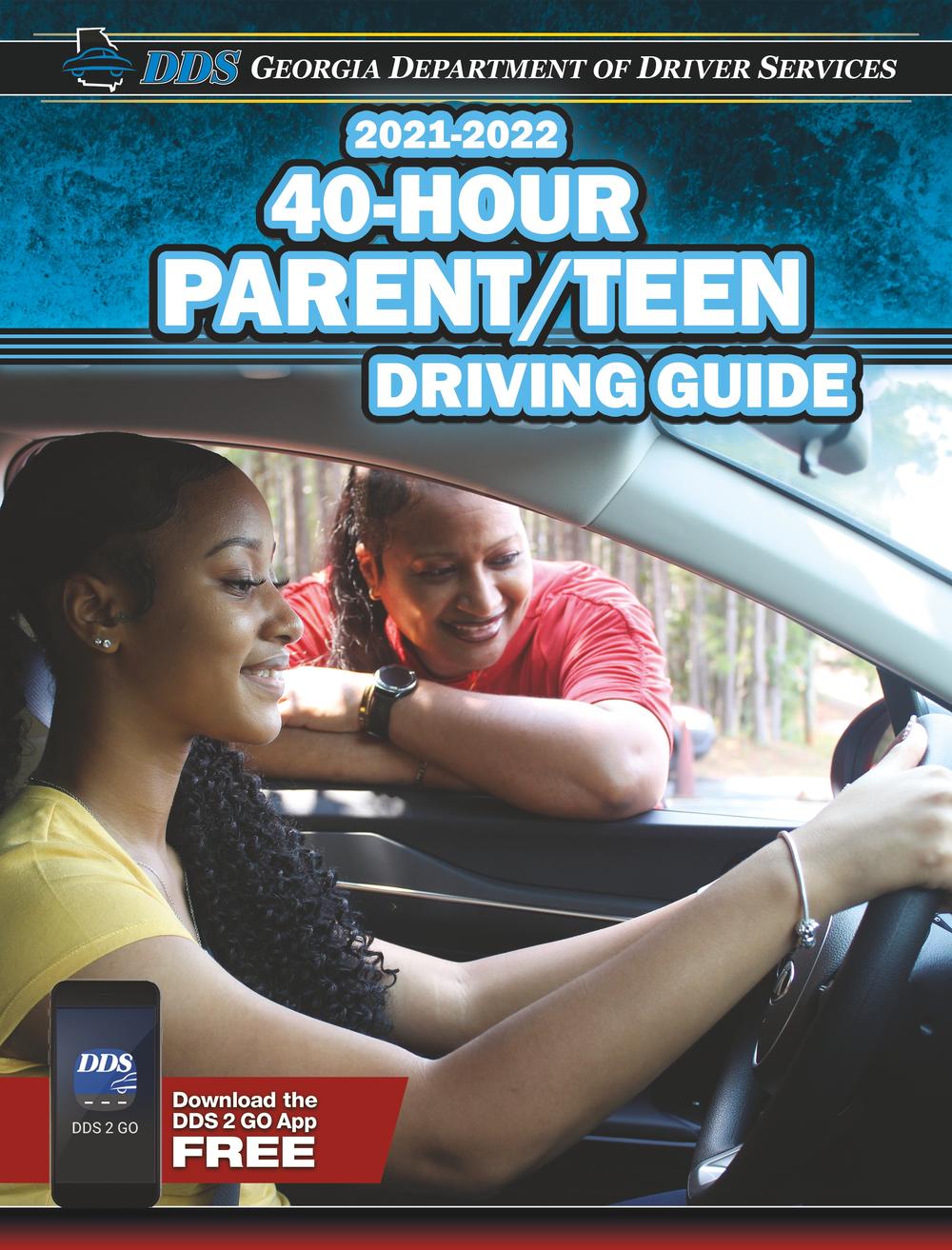
Georgia Department of Driver Services 40-Hour Parent/Teen Driving Guide, 2021–2022

Governor's Message
My Fellow Georgians,
Around the world, Georgia is recognized as a beacon of opportunity for economic prosperity. Year after year, our state achieves remarkable growth and solidifies its reputation as an unmatched destination to live, work, and thrive. Our success stems from a multitude of factors, including our business-friendly climate, streamlined government, and robust infrastructure cohesively connecting our communities.
As an international transportation hub, Georgia’s navigational system – from Atlanta’s bustling Hartsfield-Jackson Airport, vast Port of Savannah, and efficient network of railroads and roadways – facilitates travel and commerce across every region. This interconnectivity propels the economy forward, connects Georgia’s people, and offers travelers a truly breathtaking experience wherever they go.
As you navigate the Peach State’s rolling pastures and farmland, traverse impressive heights in mountainous terrain, or coast alongside beautiful waterways and diverse wildlife, the Department of Driver Services and I wish you safe passage and encourage you to exercise good judgment, follow driving laws, and prioritize safety for yourself, fellow motorists, and passengers.
Together, we can all take action to ensure safe arrivals at our respective destinations. This guide is an excellent resource to improve your understanding of the rules of the road and increase driving safety overall. Thank you for your vigilance, and safe travels to you and yours.
Sincerely,
Brian P. Kemp
Governor

The information contained in this manual is not intended to be an official legal reference to the Georgia traffic laws. It is intended only to explain, in everyday language, those laws, driving practices and procedures that you will use most often. It should be noted that the material in this manual is subject to change to comply with amended State and Federal legislation. The department’s primary statutory responsibilities are set forth in Title 40 of the Official Code of Georgia Annotated (O.C.G.A.)
DDS Customer Service Centers
This section contains the cities and addresses of all DDS Customer Service Centers (CSCs) in Georgia. Our Customer Contact Center can answer any questions you have concerning Georgia driver’s licenses. To reach our Customer Contact Center, please call (678) 413-8400. Visit the DDS website for additional information.
| City | Address |
| Albany | 2062 Newton Road |
| Alpharetta | 11575 Maxwell Road |
| Americus | 1601 North Martin Luther King Blvd |
| Athens | 1505 US Highway 29 N |
| Atlanta | 400 Whitehall Street, SW |
| Augusta | 3423 Mike Padgett Highway |
| Bainbridge | 101 Airport Road |
| Between | 1010 Heritage Pkwy |
| Blairsville | 37 Chase Drive |
| Blue Ridge | 211 Industrial Blvd |
| Brunswick | 134 Jack Hartman Blvd |
| Calhoun | 402 Belwood Road |
| Canton | 220 Brown Industrial Pkwy, Suite 200 |
| Carrollton | 512 Old Newnan Road, AMS House |
| Cartersville | 1304 Joe Frank Harris Pkwy |
| Cedartown | 1626 Rockmart Highway |
| Columbus | 8397 Macon Road, Midland, GA |
| Conyers | 2206 Eastview Pkwy |
| Cordele | 409 South Midway Road |
| Covington | 8134 Geiger Street |
| Cumming | 400 Aquatic Circle |
| Cuthbert | 608B Blakely Street, South Side Plaza |
| Dallas | 114 Justice Center Drive |
| Dalton | 235 Wagner Drive |
| Decatur | 2801 Candler Road, Suite 82 |
| Douglas | 348 Thomas Frier Sr Drive |
| Dublin | 620 County Farm Road |
| Elberton | 45 Forest Avenue |
| Evans | 4408 Evans to Locks Road |
| Fayetteville | 749 W Lanier Ave, Suite 102 |
| Fort Benning | 6691 Marchant Ave, Bldg 217 |
| Forest Park | 5036 GA Highway 85 |
| Gainesville | 1010 Aviation Blvd |
| Greensboro | 1180 C Weldon Smith Drive, Suite 108 |
| Griffin | 1313 Arthur K. Bolton Pkwy |
| Helena | 351 8th Street |
| Hinesville | 2301 Airport Road |
| Jackson | 149 Riverview Park Road |
| Kennesaw | 3690 Old 41 Hwy NW |
| Kingsland | 333 South Ashley Street |
| LaGrange | 900 Dallis Street |
| Lawrenceville | 310 Hurricane Shoals Road, NE |
| Lithonia | 8040 Rockbridge Road |
| Locust Grove | 619 Tanger Blvd |
| Macon | 200 Cherry Street, Terminal Station |
| Marietta | 1605 County Services Pkwy |
| Milledgeville | 200 Carl Vinson Road |
| Newnan | 128 Bullsboro Drive |
| Norcross | 2211 Beaver Ruin Road, Suite 100 |
| Perry | 450 Larry Walker Pkwy |
| Reidsville | 3092 GA Highway 147 |
| Rincon | 2792 Highway 21 S |
| Rock Spring | 156 Pin Oak Drive |
| Rome | 3390 Martha Berry Highway, NE |
| Sandersville | 115 Jones Street, Suite 2 |
| Savannah | 1117 Eisenhower Drive |
| Statesboro | 19051 Highway 301 N |
| Swainsboro | 994 US Highway 1 N |
| Thomaston | 281 Knight Trail |
| Thomasville | 4788 US 84 Bypass W |
| Thomson | 172 Bob Kirk Road |
| Tifton | 3057 US Highway 41 S |
| Toccoa | 62 Doyle Street |
| Trenton | 75 Case Avenue |
| Valdosta | 371 Gil Harbin Industrial Blvd |
| Warner Robins | 198 Carl Vinson Pkwy |
| Waycross | 3029 Memorial Drive |
The best time to visit DDS in person is the middle of the week during the middle of the day.
Tuesday is our busiest day statewide. Please visit the DDS website to schedule your road test appointment and submit your paperwork for service.
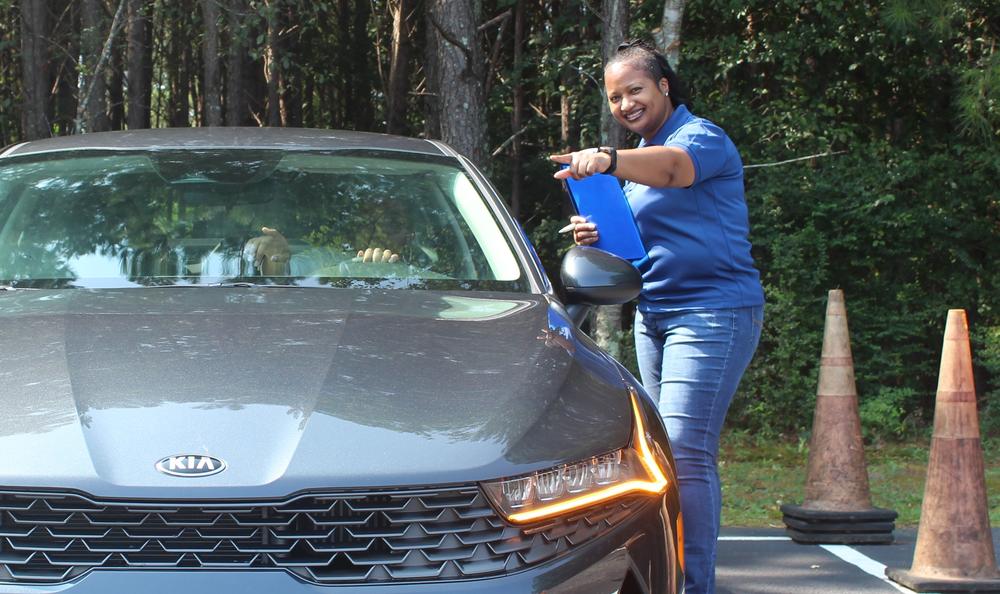
DDS Commissioner and Board Messages

Dear Parents and Future Drivers,
Reaching the age to obtain a driver’s license is one of the most exciting times in a teenager’s life. For parents and teens alike, it is a process and an experience that will be remembered for a lifetime. While the privilege to drive opens doors to many new opportunities, it also carries with it tremendous responsibilities. A solid foundation in driver education, including practice and behind-the-wheel experience, has proven to be the one of the best protections against teen driving fatalities, which continue to be the leading cause of death among teens in the United States.
I am pleased to present the DDS 40-hour Parent Teen Driving Guide, which is intended to not only provide teens with the fundamental tools necessary to be safer drivers, but also assist in satisfying the behind-the-wheel skills portion of Georgia’s teen driver education requirements. Georgia law requires that all teens under the age of 18 successfully complete a DDS-approved driver training program to obtain a Class D provisional license. Without driver training, teens are not eligible for a provisional license. When coupled with a DDS-approved 30-hour virtual or 30-hour classroom program, successful completion of this Guide will satisfy Georgia’s driver education requirements.
Please read the Guide carefully and be sure to follow all of the directions. All sessions must be completed prior to being able to take the DDS road skills test. In addition, a Driving Experience Affidavit (DDS-7) must be completed at DDS affirming the applicant has a minimum of 40 hours of driving experience, 6 hours of which must be at night. Teens without the required 40 hours will not be tested.
Also, please download the official DDS Mobile App, DDS 2 GO, for free from the App Store or Google Play. Using DDS 2 GO will allow you to save time by completing many transactions without visiting in person including upgrading your Class D Provisional License to a Class C Full License.
Best of luck and safe driving!
Sincerely,
Spencer R. Moore
Commissioner
Board of Directors' Message
Board of Directors
- David W. Connell, Chair
- Jeff MarKey, Vice Chair
- Britt Fleck, Secretary
- Tony Guisasola
- Rachel Little
- Christie Moore
- Bob Pierce
- Sheriff Frank Reynolds
- Kat Satterfield
The Department of Driver Services (DDS) Board of Directors would like to remind our customers that driving in Georgia is a privilege that carries many responsibilities. Please be a safe and dependable driver to ensure that this privilege will not be lost. This manual has two main purposes:
- to help you qualify for a Georgia driver's license; and
- to help you become a safer driver.
Please always put safety first!
DDS Mission & Core Values
Our Mission
To provide secure driver and identity credentials to our customers with excellence and respect.
Our Core Values:
- Trusted Service
- Ethical Actions
- Accountable to All
- Motivated to Excellence
#ExcellenceIsWhatDRIVESUs
Title VI Policy Statement
The Georgia Department of Driver Services (DDS) is committed to compliance with Title VI of the Civil Rights Act of 1964 and all related nondiscrimination authorities. DDS assures that no person shall, on the grounds of race, color, national origin, sex, age, disability, low-income, and Limited English Proficiency (LEP), be excluded from participation in, be denied the benefits of, or be otherwise subjected to discrimination under any program or activity. DDS further assures that every effort will be made to ensure nondiscrimination in all of its programs and activities, whether or not those programs and activities are federally funded. In addition, DDS will take reasonable steps to provide meaningful access to services for persons with Limited English Proficiency. Finally, DDS written agreements with any party for federally funded programs or services will include Title VI language as provided in the Title VI Program Assurances.
Acknowledgements
Deputy Commissioner's Message
Dear Parents and Prospective Drivers,
As Deputy Commissioner of the Georgia Department of Driver Services (DDS), and on behalf of all of our staff, it gives me great pride to be able to present to you the DDS 40-hour Parent Teen Driving Guide. If you are reading this Guide, it most likely means that you are not only the parent or guardian of a teen who is seeking to obtain a Class D provisional license, but also will be using its training materials in order for your teen to satisfy the behind-the-wheel component of Georgia’s driver training requirements.
As a highway safety professional, I firmly believe that driver education not only creates safer drivers on our roadways, but also has proven to be the one of the best highway safety investments we can make in order to reduce teen driving fatalities. I also firmly believe that motor vehicle crashes and the fatalities and injuries they cause are preventable. According to the latest statistics published by the Georgia Governor’s Office of Highway Safety, in 2019, there were 1,491 motor vehicle fatalities reported in Georgia. 384 of these fatalities were the result of not being properly restrained by a seatbelt; 353 were the result of impaired driving; and 260 were the result of speeding. Distracted driving also continues to be a grave concern to highway safety and a contributing factor in many crashes. Remember, please, to buckle-up, slow down, never drive impaired, and always pay attention while driving. Put the phone down. No phone call, text message, or email is worth the risk it poses to you, passengers in your vehicle, or other drivers.
Please download the free Mobile App, DDS 2 GO, and save time finding information and conducting many licensing transactions.
Sincerely,

Ricky H. Rich
Deputy Commissioner
40-Hour Parent/Teen Driving Guide
The Georgia Department of Driver Services (DDS) wishes to gratefully acknowledge the contributions, information, and materials provided as a part of the “40-Hour Parent/Teen Driving Guide” (Guide) by the Virginia Department of Education.
The guide is made available as a public service, without express or implied warranties of any kind and DDS expressly disclaims liability for errors and omissions in the guide. The following notices and disclaimers also apply:
- DDS has compiled the materials for the GUIDE exclusively for its noncommercial, nonprofit, educational use. Any review or use of the GUIDE is limited exclusively to noncommercial, educational review, and the contents of the GUIDE may not be used for any commercial purposes.
- Certain materials and information included within the GUIDE are protected by United States and foreign copyright, trademark and other intellectual property laws. The material and information included within the GUIDE is the property of DDS, the Virginia Department of Education, or other parties, and DDS and such other parties each have the right to enforce their rights therein.
- DDS has either obtained or is in the process of obtaining the necessary permissions, rights, assignments, or licenses for those materials that DDS does not already own. Because the copyrights or other intellectual property rights of certain materials may be held by third parties other than DDS, any persons wishing to copy, use, disseminate, modify or otherwise do anything with the GUIDE are hereby placed on notice that the following activities may constitute a violation of the rights of the copyright or other intellectual property rights of such other owners, for which DDS expressly disclaims any and all liability. Until all necessary rights have been obtained, possession, use and copying of the GUIDE will be limited to the rights DDS owns, has obtained or has been granted, the rights granted under the fair use doctrine and other provisions of the Copyright, intellectual property and other laws of the United States and the State of Georgia, and the rights and obligations imposed by the open meetings and open records laws of the State of Georgia.
- No person or entity may modify, copy, reproduce, republish, upload, post, distribute, broadcast, transmit, retransmit, display, perform, publish, license, create derivative works of, transfer, sell, or resell the GUIDE in whole or in part or in any way without the prior, express, written permission of the owner thereof, and one cannot assume that DDS is the owner in every instance. Any copyright, trademark, and other notices must remain intact. Unauthorized use of the logos, designs and trademarks of DDS or other third parties is not permitted. Nor may any person or entity in any way violate the copyright or other intellectual property rights of DDS or any provider of information, content, products or services to the GUIDE.
- Any commercial, for-profit or other unauthorized use of these materials owned by third parties without the express written permission of such third party and DDS may be actionable and is not authorized. Neither DDS nor its contributors shall be held liable for any improper or incorrect use of the materials and information described and/or contained in the GUIDE and DDS or its contributors assumes no responsibility for anyone’s use of, or actions with respect to, the GUIDE or materials and information contained therein.
- Since the GUIDE contains content that is supplied by third parties, any opinions, advice, statements, services, offers, or other information or content expressed or made available by third parties, including information providers, users, or others, are those of the respective authors or owners and do not necessarily state or reflect those of DDS.
- All GUIDE materials and information are provided “AS IS” without warranty of any kind. DDS makes no representations and, to the fullest extent allowed by law, disclaims all warranties, express or implied, including, but not limited to warranties of merchantability and fitness for a particular purpose regarding the accuracy, reliability, suitability, completeness or timeliness of any items contained within the GUIDE.
- Neither DDS nor its contributors shall be held liable for any improper or incorrect use of the information described and/or contained in the GUIDE, and DDS assumes no responsibility for anyone’s use of the GUIDE or information contained therein.
- In no event will DDS or its contributors be liable for any damages whatsoever arising out of the use or inability to use the GUIDE or any items or information contained therein even if advised of the possibility of such damages. In no event shall DDS or its contributors be liable for any direct, indirect, incidental, special, exemplary, or consequential damages (including, but not limited to, procurement of substitute goods or services; loss of use, data, or profits; or business interruption) however caused and on any theory of liability, whether in contract, strict liability, or tort (including negligence or otherwise), arising in any way out of the possession or use of the GUIDE even if advised of the possibility of such damage.
- DDS does not endorse individual vendors, products or services. Reference herein or in the GUIDE to any specific commercial products, processes, or services by trade name, trademark, manufacturer, or otherwise, or the use of any trade, firm, or corporation name, does not constitute or imply DDS’s endorsement, recommendation, approval or favoring by DDS, and such reference shall not be used for advertising or product endorsement purposes.
- In the State of Georgia, laws exist to ensure that government is open and that the public has a right to access appropriate records and information possessed by state government. At the same time, there are exceptions to the public’s right to access public records. These exceptions serve various needs, including maintaining the privacy of individuals. Both state and federal laws provide exceptions. The GUIDE is expressly subject to the open records and open meetings laws of the State of Georgia.
- Anyone doing anything with the GUIDE agrees to defend, indemnify, and hold harmless DDS and its contributors and their respective directors, officers, employees, and agents from and against all claims and expenses, including attorneys’ fees, arising out of the possession, copying or other use of the GUIDE by such user or for such user’s account.

All requests or questions with respect to the GUIDE should be sent to: Georgia Department of Driver Services, Governmental Affairs and Communication Division, 2206 Eastview Parkway, Conyers, Georgia 30013
Parenting the Driving Experience
Your teen has reached an important milestone; an INSTRUCTIONAL PERMIT (also known as the Learner’s Permit). It is our hope that acquiring mature driving skills and judgment will be a rewarding experience for you and your teenager. With your involvement, it can also be a safe experience. This 40-hour parent/teen driving guide provides suggestions for in-car lessons to help you assist your teen in making this step to adulthood more successful for both of you.

How do you teach a 16-yearold not to be a 16-year-old behind the wheel of an automobile? Unfortunately, there is no magic formula to prepare your teenager for the responsibilities of driving. Driver education at its best is a team effort involving schools, communities, students, and families.
Cars do not crash; people crash them. In 2016, there were 188 roadway fatalities in Georgia among persons under age 21. Motor vehicle crashes are the leading cause of death of teens in the United States (based on the latest mortality data currently available from the National Center for Health Statistics). According to the Insurance Institute for Highway Safety, 2,820 drivers ages 13-19 were killed in motor vehicle crashes nationally in 2016.
The Teenage & Adult Driver Responsibility Act (TADRA) was established in Georgia by a collaborative effort of highway safety advocates, legislators, law enforcement officials, educators, businesses and media in the wake of a high number of fatal vehicle crashes involving young, inexperienced drivers. TADRA involves an intense, three-step education process that allows the young driver to gain more experience behind the wheel. Additionally, it also requires that prior to the issuance of a Class D license you must have completed a cumulative total of at least forty (40) hours of other supervised driving experience, including at least six (6) hours at night.
Those under age 18 applying for a Class D driver’s license must complete an approved driver education course and complete a total of 40 hours of supervised driving, 6 hours of which must be at night, with a parent or guardian’s sworn verification that these requirements have been met. This manual is designed to help you achieve the required driving experience to qualify for a Class D driver’s license.
The ability to move a car skillfully is not the same thing as the ability to drive safely. Steering the vehicle is a relatively simple skill that most people can master in a short period of time. Driving is a complex task requiring mastery of various performance skills. It requires processing and accurately evaluating risk in the driving environment, developing appropriate responses to minimize risk, and gaining experience to predict what action others may take.
This technical assistance guide provides you with a systematic approach to guide your teen towards remaining crash-free in both low- and high-risk driving environments. The suggested lessons in this guide follow a sequential learning pattern that progresses from the parking lot to neighborhoods, to light traffic, to rural highways, to expressways and then to city driving. Each lesson provides you with an estimated amount of time the teen will need to achieve mastery; however, because teens have different abilities and learning styles you need to spend as much time as necessary to allow your teen to master the skills before moving on to the next lesson. Research shows that in order for young drivers to remain crash-free, parents must model safe driving behaviors and invest in meaningful guided practice over a long period of time to turn these skills into good driving habits!
If neither parent has a valid driver’s license, a friend or relative can conduct the guided practice sessions. Because parents and guardians play such a significant role in the development of safe driving habits, parents should remain involved in the learning process as observers in the car during the guided practice sessions. Knowing your teen is a skilled, safety-conscious driver will give you peace of mind in the years to come.
In addition to sharpening your driving skills, it is our hope the guided practice sessions presented in this guide will provide your teen with a solid foundation to develop safe, free driving habits that will last a lifetime.
Introduction
Teenage & Adult Driver Responsibility Act (TADRA)
The Teenage and Adult Driver Responsibility Act (TADRA) was enacted on July 1, 1997. TADRA established a graduated driver’s license program for young drivers ages 15 to 18 in Georgia. This act directly addresses the leading killer of our young people – traffic crashes. The law significantly changes the way young motorists earn and maintain the privilege of driving by providing a controlled means for new drivers to gain experience, and by reducing high-risk driving situations. While the law does focus on young drivers, it also contains important provisions that affect drivers over 21, particularly in the area of DUI prevention and enforcement.
TADRA involves an intense, three-step education process that allows the young driver to gain more experience behind the wheel:
Step One – Instructional Permit (Class CP)
Class CP permit fee – $10.00
Payable in cash, money order, check or credit card.
In order to apply for an Instructional (Learner’s) Permit (Class CP), all applicants must meet the following requirements:
- You must be at least 15 years of age.
- Fee must be paid before the test begins.
- You must pass a vision exam and a knowledge exam.
- If you are under 18 years of age, a parent, guardian, or authorized driver training instructor must sign the application for Instructional Permit. The signer also has the authority to request the revocation of the Instructional Permit at any time before your 18th birthday.
- If you are new to Georgia, you must surrender any out of state driver's license/permit/ID card.
- If you were previously issued a driver's license/permit in another state, and that card has been lost or stolen, you must provide a certified copy of your motor vehicle report (MVR) from the state that issued the card. The MVR must be dated within the last 30 days. The DDS does not accept uncertified copies printed from websites, but a fax may be sent to the DDS directly from the other state agency.
- If you are under 18 years of age, you must present a notarized Certificate of School Enrollment (DS-1) form from your school signed within the last 30 days, a high school diploma or GED.
- All documents must be in English.
Step Two – Provisional License (Class D)
Class D license fee – $10.00
Payable in cash, money order or credit card.
In order to apply for a Provisional License (Class D) all applicants must meet the following requirements:
- You must be at least 16 years of age.
- You must have held an Instructional Permit (Class CP) for a minimum of one year and a day. Your permit must also be surrendered at the time of testing.
- You must not have been convicted of any traffic violations that prohibit issuance of a Class D.
- You must have completed a minimum of 40 hours of supervised driving experience, 6 hours of which must be at night.
- Anyone under 18 years of age must meet the driver training requirements of Joshua’s Law.
- You must pass a vision exam and road skills test.
- If you are under 18 years of age, a parent/ guardian, or authorized driver training instructor must sign the application for the driver’s license. The signer also has the authority to request the revocation of the driver’s license at any time before your 18th birthday.
- If you are new to Georgia, you must surrender any out-of-state driver’s license/permit/ID card.
- If you were previously issued a driver’s license/permit in another state, and that card has been lost or stolen, you must provide a certified copy of your motor vehicle report (MVR) from the state that issued the card. The MVR must be dated within the last 30 days. The DDS does not accept uncertified copies printed from websites, but a fax may be sent to the DDS directly from the other state agency.
- If you are under 18 years of age, you must present a notarized Certificate of School Enrollment (DS-1) form from your school signed within the last 30 days, a high school diploma or GED.
- You must present your ADAP or eADAP certificate of completion.
- If the Parent Teen Driving Guide was used to satisfy the Joshua’s Law “Behind the Wheel” requirement, you must sign the Driving Experience Affidavit (DDS-7) provided at DDS affirming you have a minimum of 40 hours of driving, 6 of which must be at night.
- All documents must be in English.
Class D Provisional License Conditions
- No driving between the hours of 12:00 a.m. and 5:00 a.m. No exceptions.
- During the first six months after issuance, no driving with passengers who are not members of the driver’s immediate family;
- For the second six month period, no driving with more than one passenger under the age of 21 who is not a member of the driver’s immediate family;
- After one year from the date of issuance, no more than three passengers under the age of 21 who are not members of the driver’s immediate family.
The Parents’ Role in the Young Driver’s Licensing Process
- Grant the Department of Driver Services permission to issue their young driver an Instructional Permit and a Class D Driver’s License.
- Provide their teen with at least 40 hours of supervised driving experience, 6 hours of which must be at night.
- Ensure that teens under 18 complete an approved driver education course prior to applying for a Class D license.
- Limit the teen’s driving privileges if he or she is not demonstrating responsible behavior.
- Continue to monitor their teen’s driving after receipt of their provisional license and reinforce safety belt use, passenger restrictions, and hands-free cell phone use.
- Serve as a positive role model by demonstrating safe driving behaviors.
Parent Tips for In-Car Guided Practice Sessions
Parental reinforcement of basic driving skills and good decision-making will lead to safe driving habits that will last a lifetime.
- Enjoy your time together. Have fun! This is a great “bonding” opportunity. Focus on the driving task and leave family issues at home.
- When you drive, set a good example to model. Always wear your safety belt. Try to correct any unsafe driving habits that you may have acquired; such as rolling through stop signs, accelerating through yellow lights, exceeding the speed limit, driving distracted, etc.
- If possible, initial instruction should begin in a car with an automatic transmission so that your teen can focus on mastering basic vehicle control maneuvers.
- Select driving environments that complement the lesson objectives and the novice driver’s ability. Start in parking lots and progress to quiet neighborhoods. Stay in a safe, low-risk environment as long as needed and, in the beginning, practice using driving routes familiar to your teen.
- Check to make sure your teen has their Instructional Permit and insurance information with him or her when operating a vehicle.
- Explain the objectives of each lesson and review what was learned in the last lesson.
- Feedback should be precise and immediate. If a mistake is made, repeat the maneuver, taking the driver step by step through the process, and then allow practice without assistance.
- Be patient, calm, and alert at all times. Make positive remarks frequently.
- Have short, well-planned practice sessions. Thirty minutes is the optimum learning period for beginning drivers. The first 30 minutes of each one-hour session should be used to introduce and practice the new skills. Assess the teen’s understanding of the lesson objectives during the second half of the session. Set high standards and evaluate each driving session together.
- In a parking lot, practice steering the car with your left hand from the passenger seat.
- If you have a car with a parking brake between the seats, practice stopping the car by depressing the release button and raising the parking brake.
- To prepare yourself to regain speed control in the event your teen panics, practice shifting the transmission from drive to neutral from the passenger seat.
- Adjust the mirror on the passenger sun visor so you can use it as a rearview mirror. If the right outside mirror is properly adjusted to eliminate blind spot and glare, you can also use that mirror to monitor traffic to the rear from the passenger seat. (see the information under the heading "Contemporary Mirror Setting")
- Keep instructions simple and concise. First direct where to go, and then state the action to take (e.g., “At the next intersection, turn right.”)
- Check mirrors and the space to the sides and ahead of the vehicle before giving directions.
- Emphasize driving with a large anticipation zone by looking at least 15-20 seconds ahead. Think “what if”; what if a car suddenly changes lanes, stops, turns, etc.
- Encourage commentary driving! This is the most valuable tool you have for checking how your teen is using driving skills and evaluating the environment. Ask your teen to “read the traffic picture aloud” describing anything that may affect your path of travel. For example, when your teen changes speed, your teen may say: “red light, mirror, ease foot off accelerator and brake.” Actually, you should hear “mirror and ease off accelerator” a lot!
- Reinforce the fact that a green light means one must scan the intersection before proceeding.
- Encourage your teen not to panic when approached by an emergency vehicle and to focus on looking for a safe area to pull over.
- Discuss the rules for passing a stopped school bus with flashing lights.
- Encourage new drivers to change their route to avoid making a difficult left turn.
- There is a lot to learn in each lesson, so your teen may need extra time to attain adequate skill proficiency. Mastery at each level is important before moving on to the next lesson.
- If possible, integrate night driving into each area of instruction.
Driving in the 21st Century
Improvements in auto and highway design also have increased highway safety. Many new cars are equipped with safety features that dictate basic vehicle control procedures. Drivers must understand these new technologies and the need for basic vehicle maintenance.
Tires, wheels, brakes, shock absorbers, drive train, steering and suspension systems function together to provide a safe, comfortable ride and good gas mileage.
Tires
Properly inflated tires are critical to vehicle control and good gas mileage. Tires should be inflated to the vehicle manufacturer’s recommended pressure printed on the vehicle’s door placard or in the owner’s manual, not the maximum limit listed on the tire sidewall. Under-inflated tires flex too much and build up heat, which can
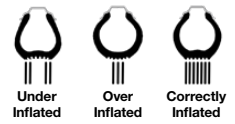
lead to blowouts or the tread separating and peeling off. The actual size of the tire patch in contact with the road is about the size of a dollar bill. These four dollar bill size patches of rubber in contact with the road surface allow the vehicle to respond to acceleration, braking, and steering. With this narrow margin of safety, it is important to check tire pressure at least once a month. Proper tire tread reduces traction loss on wet surfaces by channeling water through the tread. Government tire ratings are listed on the side of the tire. The “AA” rating is the top traction, speed, and load rating, and “C” is the lowest tire rating.
Prior to entering vehicle check tire pressure using recommended psi located in the door jam of the vehicle. Use a tire pressure gauge to check your psi. If your psi is above the number listed on your door jam, let air out until it matches. If below, add air (or have a retailer help you) until it reaches the proper number.
You may also measure tread depth using the penny test. Once every month, or before you embark upon a long road trip, check your tires for wear and damage problems. One easy way to check for wear is by using the penny test.
- Take a penny and hold Abraham Lincoln’s body between your thumb and forefinger.
- Select a point on your tire where the tread appears the lowest and place Lincoln’s head into one of the grooves.
- If any part of Lincoln’s head is covered by the tread, you’re driving with the legal and safe amount of tread. If your tread gets below that (approximately 2/32 of an inch), your car’s ability to grip the road in adverse conditions is greatly reduced.
Steering Control
Due to changes in steering ratios and effort needed to turn the wheel, steering control requires a balanced hand position on the lower half of the steering wheel.
Hand Position
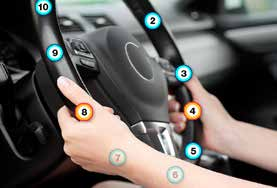
Good posture while driving is important because it allows a better view of hazards and more control of the vehicle. As a general rule, when gripping the steering wheel, place your left hand at the 9 o’clock position and your right hand at the 3 o’clock position on the wheel. Some manufacturers recommend placing your hands at 8 o’clock and 4 o’clock positions when the vehicle is equipped with steering wheel air bags. Check your owner’s manual or contact your vehicle manufacturer to determine which position is best for your vehicle. Always keep both hands on the wheel unless you are safely performing another driving-related task, such as activating your turn signal.
Steering—Hand-to-Hand/Push-Pull-Slide Steering
This steering technique keeps both hands on the wheel at all times and reduces excessive steering wheel movement. In the event of a frontal crash with a vehicle equipped with an air bag, this steering method also reduces the chance of injury because the arms do not cross over the steering wheel where the air bag is housed.
To push/pull steer:
- the right hand begins at 3 o’clock or below;
- the left hand begins at 9 o’clock or below;
- the right hand moves between the 5 and 2 o’clock position; and
- the left hand moves between the 7 and 10 o’clock positions.
To reverse the push-pull-slide process, allow the steering wheel to slide through the hands until the vehicle’s wheels move to the straight-ahead position.
Hand-over-Hand Steering
In modern cars, this steering technique is used only when the vehicle is moving very slowly or is stopped, and the vehicle needs to be turned in a very sharp angle. For hand-overhand steering:
- one hand grasps the wheel and pushes the wheel up, over, and down;
- at the same time the other hand releases the wheel and passes across the forearm to grip the wheel on the far side;
- this hand then pulls the side of the wheel up, over the top, and down; and
- these movements continue as long as necessary to turn the wheel as much as needed.
Brakes
Brakes play a vital role in your family’s safety when on the road. Brakes pads or shoes provide stopping power for your vehicle and should be in good working order. They usually last about 30,000 miles, depending on the driving conditions. Refer to the owner’s manual for recommended maintenance tips for your brakes.
Anti-lock Braking System (ABS)
Cars with anti-lock braking systems automatically check the system when the car is started. In order to stop suddenly in an ABS equipped vehicle, you must use firm brake pressure and maintain this pressure on the brake pedal even if you feel it pulsing or hear a grinding noise. The ABS system pulses the brake 15 times a second to avoid lockup and allows your wheels to keep rolling. Rolling wheels allow you to steer—you cannot change direction if your wheels are sliding. You and your teen should practice applying the hard braking mode in a vacant parking lot before having to use this crash-avoidance technology in a real emergency.
Air Bags
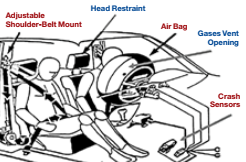
Driver and Front Passenger air bags are designed to inflate in a frontal impact. Drivers should sit at least 10 inches from the air bag because it inflates to six or seven inches in size at speeds up to 200 mph. Tilt the steering wheel as far down as comfortable to point at your chest, not at your face. Always wear a seat belt and secure children in the rear seat. To reduce forearm and hand injuries, hands should be placed on the lower half of the steering wheel, with knuckles on the outside and thumbs stretched along the rim of the wheel.
Side Impact air bags are designed to protect the torso and head in side impact crash. Care should be taken not to sit too close to the door or to lean towards the air bag.
Traction Control
Traction control systems monitor any difference in rotational speed between the front and rear wheels. This differential in wheel rotation may occur on uneven or slippery surfaces. When the system is activated, an automated combination of brake and/or engine control comes into play to provide controlled acceleration and tire traction.
Contemporary Mirror Setting
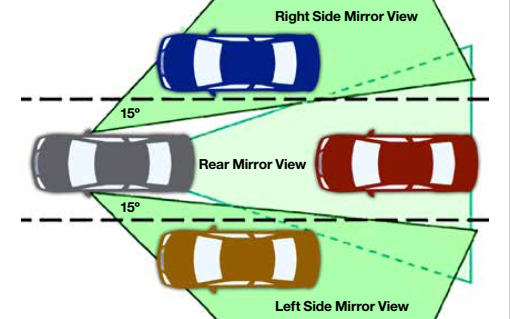
Adjust the inside mirror so that it frames the entire rear window and becomes the primary mirror for viewing what’s behind the vehicle. Adjust side mirrors to reduce the blind spot and headlight glare from the rear. Adjust the left side mirror by leaning your head towards the left side window, and set the left mirror so that the driver can barely see the side of the car. To adjust the right side mirror, lean to the right over the center console, and set the right mirror so the driver can barely see this side of the car. These adjustments provide a 15 degree viewing area to each side of the vehicle. This mirror setting reduces the overlap between the inside and sideview mirrors and allows the driver to monitor the adjacent lane. Traditional settings overlap with the rearview mirror view and should only be used if the view of the highway from the inside rearview mirror is blocked.
Backup Camera
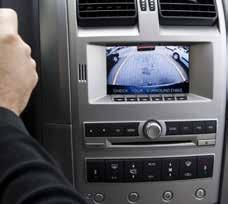
A rear view camera shows a simple video feed from a camera on the rear of the vehicle. Some systems also have overlay distance and trajectory lines to help the driver judge vehicle position. The back-up camera’s field of vision is directly behind the vehicle, and is at least 10 feet wide and 20 feet in length. Families touched by backover tragedies, especially those involving children, have pushed hard to require back-up cameras in all vehicles by 2018.
Tips for Driving in Adverse Conditions
Driver Inattention
Driver inattention is a primary cause of crashes. Distractions, such as interacting with passengers, texting/talking on the phone, or adjusting the radio, are especially dangerous for young drivers. Limit distractions by pulling off the road to perform activities not related to the driving task.
Drowsy Driving
Fatigue or drowsy driving severely limits your reaction time and decision-making ability, and is caused by lack of sleep, the body’s circadian rhythm, and driving for long periods of time. Circadian rhythm is the body’s natural “downtime”, which for most people is between 1 and 5 p.m. and around your normal bedtime. To avoid fatigue, take breaks, keep the vehicle cool, and be aware of your “downtime”.
Glare
Sources of glare include headlights of oncoming or following vehicles, misaligned headlights, improperly loaded vehicles, a dirty windshield, paper on the dashboard, facing the sun at dusk or dawn, snow-covered landscapes, and traditional versus contemporary side mirror settings. To combat glare, wear sunglasses during the day only, adjust sun visor as needed, keep windows clean, reduce speed, and look to the right-hand side of the road when meeting a vehicle with high beam headlights on.
Fog

During foggy conditions, reduce speed, use low beams, windshield wipers, and defroster/ defogger and flashers if needed, and look for a safe area to pull off the road.
Heavy Smoke, Rain, or Snow
Reduce speed, turn on low-beam headlights, emergency flashers, and windshield wipers; make gentle steering, accelerating, or braking actions; be alert for stopped vehicles on the highway, and be prepared for wind gusts or strong steady crosswinds; turn on the radio to monitor weather and road conditions, and if possible, leave the highway.
Low Water Crossing

Nearly half of all flash flood fatalities are vehicle related. In severe rainstorms watch for flooding at bridges and low areas. Driving too fast through low water will cause the vehicle to hydroplane and lose contact with the road surface.
Hot or Cold Temperatures
Hot or cold temperatures place demands on tires, radiator coolant, hoses, connections, and drive belts and increase driving risks. Check these items prior to and after driving during these conditions.
Strong Wind
Strong wind conditions create a problem for drivers called buffeting. This occurs on bridges, through mountain passes and ravines, and when being passed by large trucks. Reduce speed, check traffic, be prepared to steer windward, and countersteer in the direction you want the vehicle to go.
Head-On Crashes
The possibility of serious injury or death is greater in a head-on crash. This type of crash is more likely to occur on two-lane highways, in narrow lanes or on curved roads, and in construction zones.
Rear-End Crashes
Rear-end crashes are one of the most common types of multiple-vehicle crashes. Tailgaters cause many rear-end crashes. Adverse conditions such as dense fog or smoke, heavy rain, and snow also increase risks to motorists because some drivers stop their vehicles while still on the highway.
Side-Impact Crashes
Most vehicles are not well-equipped to withstand a side impact. If your vehicle is in danger of being hit, your best option is to accelerate rather than apply brakes if the way ahead is clear.
Changing Traction Conditions

Traction or adhesion is the grip the tires have on the road surface, which allows the vehicle to start, stop, and/or change directions. As speed increases, traction between the tires and the road decreases. Three kinds of traction influence motor vehicle control: static, rolling (dynamic), and sliding. Road surface conditions that decrease the level of traction are ice, snow or frost, wet surfaces or standing water, mud or wet leaves, uneven surfaces, sand, gravel, and curves. Speed should be reduced in such conditions.
DDS 2 GO Mobile App
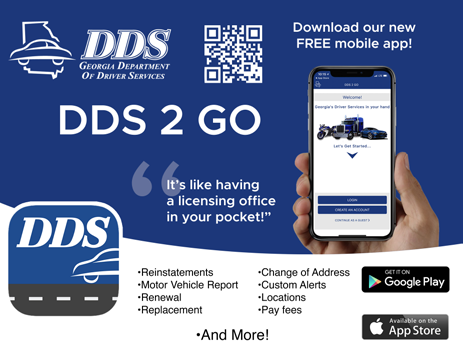
DDS 2 Go Long Description
Download our new free mobile app!
"It's like having a licensing office in your pocket!"
- Reinstatements
- Motor Vehicle Report
- Renewal
- Replacement
- Change of Address
- Custom Alerts
- Locations
- Pay fees
- And more!
Available on the Apple App Store and Google Play.
Sessions 1 & 2
Getting Ready, Starting, Placing the Vehicle in Motion, and Stopping
Sessions 1 and 2 should be divided into four 30-minute periods. These sessions introduce your teen to the instrument panel, vehicle controls, and mirror blind spots. Please review the vehicle owner’s manual before and during these sessions. You will need a measuring tape, cones, or plastic cups to use in these and future lessons.
Begin in a large, level parking lot free of obstacles. Use the checklist under the heading "Checklist for Sections 1 & 2" to help organize your lessons and assess learning during the second half of session 2.
- Prior to entering the vehicle, the teen should check for fluid leaks, broken glass, objects behind the vehicle, etc.
- Check tire pressure, engine oil, radiator, and other fluid levels.
- Enter the vehicle and review interior controls; turn on the ignition switch to discuss functions of lights, gauges, and accessories. Ask your teen to operate and explain all controls and to simulate monitoring the path ahead while operating the controls.
- Discuss how the proper seating position is essential for control of the vehicle. The driver should sit with his or her back firmly against the seat with at least 10 inches between the steering wheel and the driver’s chest. The air bag should point towards the driver’s chest. The top of the steering wheel should be no higher than the top of the driver’s shoulders.
- Adjust the seat to maintain heel contact with the floor to pivot the foot between the brake and accelerator pedals. Short drivers may need a seat cushion or pedal extenders to sit in a safe position at least 10 inches from the air bag.
- Adjust the head restraint to align with the center of the back of the driver’s head.
-
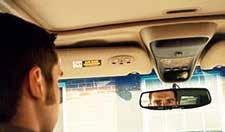
- Seat belts must be worn properly to prevent injuries. The lap portion should be snug across the hips, and the shoulder portion should be worn snug across the chest away from the neck and face. Improper use may cause injuries.
- Practice starting the vehicle and adjusting accessories.
-
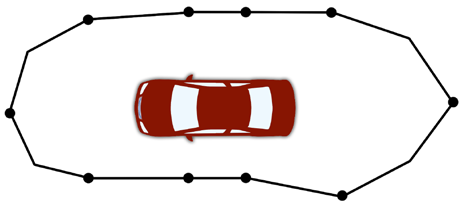
- With the right foot firmly on the brake, have your teen shift through the gears and explain when each gear is used.
- If the vehicle does not have daylight running lights, turn on the low-beam headlights.
- Press the brake pedal, release parking brake and shift to drive.
Ask the new driver to move the vehicle to different points in the parking lot using little to no acceleration. Have your teen stop at designated lines. Focus on smooth acceleration and stopping.

Ask your teen to drive around the perimeter of the lot and focus on push-pull-slide/hand-to-hand steering. Coach your teen by saying “slow” until the vehicle comes to a stop. Once you have developed that skill into a habit, progress to saying “slow to a stop”. Use the command “stop” only when you need your teen to make a hard, emergency stop. Treat these practice maneuvers as simulating stopping and turning at an intersection. Using commentary driving, ask your teen to say, “clear left, clear right, clear left, clear ahead” from a stop and “clear left, clear right, clear ahead” while moving. Make sure your teen signals and checks mirrors and blind spots prior to changing speed, position or direction. Focus on continuous and smooth steering wheel movements into the turn, and returning (sliding) the wheel through the hands using the same smooth continuous movements until the vehicle is in the proper position in the lane. Discuss the vehicle’s forward pivot point, which on most cars is even with the driver’s body. Coach your teen to focus on looking at and steering towards a target in the center of your intended path of travel.
Checklist for Sessions 1 & 2
Area around the vehicle that the driver cannot see
- Measure the distance in front of the vehicle that the driver cannot see
- Measure the distance to the rear of the vehicle that the driver cannot see
- Measure the distance to the left side of the vehicle that the driver cannot see
- Measure the distance to the right side of the vehicle that the driver cannot see
Place “S” for satisfactory as the following tasks are completed:
Getting Ready to Drive
- Approaches the vehicle with awareness; checks tires, fluid leaks, etc.
- Locks doors and checks all occupants for safety belt use
- Adjusts head restraints, seat position, safety restraints, steering wheel position
- Adjusts mirrors to reduce blind spots
- Identifies vehicle controls (refer to owner’s manual for explanation)
Starting the Vehicle
- Checks the parking brake
- Selects proper starting gear
- Pivots heel and places foot securely on brake pedal
- Demonstrates proficient use of ignition device
- Demonstrates ability to select and use appropriate accessories
- Starts the vehicle and makes appropriate gear selection for movement
- Puts headlights on day and night to increase safety
Placing Vehicle in Motion
- Visually identifies open space and target before moving foot from brake to gas
- Communicates with passengers before moving foot from brake to gas
- Puts the vehicle in motion smoothly and uses commentary driving
Stopping Vehicle in Motion
- Searches ahead of the vehicle to determine deceleration or braking needs
- Uses controlled braking efficiently with heel of foot on floorboard
- Checks rear zone space prior to braking
- Applies adequate force at the beginning of the braking process
- Brings the vehicle to a smooth stop
- Eases off brake pressure during the last seconds of braking to reduce vehicle pitch
- Checks the rear zone space before, during, and after braking
Steering
- Uses a balanced 8 and 4 hand position on the steering wheel
- Uses the hand-over-hand and hand-to-hand steering methods effectively
- Turns head and visually checks what’s ahead prior to turning
- Visually checks the rear/side view mirrors and mirror blind areas
Securing the Vehicle
- Sets parking brake; shifts into appropriate gear before removing foot from brake
- Turns off appropriate accessories prior to turning off ignition and removing key
- Visually checks traffic flow before opening door
- Locks doors and activates alarm system if the vehicle is equipped with this device
Sessions 3-5
Moving, Stopping, Steering, Knowing Where You Are
Sessions 3-5 focus on learning the correct procedures for moving, stopping, using reference points, and steering the vehicle at different speeds. Review previous lesson objectives, and divide sessions into six 30-minute periods. If possible, drive at night during one session. Assess learning during the second half of session 5. Begin in a large, level parking lot that is free of obstacles. Place cones or other “targets” at selected locations on the lot.
The teen should practice driving around the perimeter of the lot at 10 and 15 mph. Using commentary driving, have your teen focus on smooth push-pull-slide/hand-to-hand steering and stops. Your teen should be coached to ease off the accelerator or use the brake to reduce speed before entering a curve and use slight acceleration to overcome inertia and pull the vehicle out of the curve. Novice drivers have a tendency to overuse the brake and under use the accelerator to control speed, so coach your child to only use the brake to reduce speed quickly.
Ask the teen to move the vehicle to specified targets in the parking lot at 10 and 15 mph. Focus on smooth acceleration, proper speed, and smooth stops. Explain to your teen that “curling” the toes back to ease pressure off the brake just before stopping results in smoother stops. Practice normal smooth stops and hard smooth stops which are done at a slightly higher speed.
Reference Points
Reference points help drivers know the location of their vehicle in relation to a pavement line or curb in the roadway. To know exactly where the vehicle is located, at speeds under 25 mph the young driver can align some part of the vehicle with the roadway. Practice establishing left, right, and front reference points 10 or 12 times during each session. Exchange places with your teen to demonstrate using left, right and front reference points.
Left-Side Reference Point

To align the vehicle 3-6 inches from a pavement line or curb on the driver’s side of the vehicle, the driver should stop when the line or curb appears to intersect a point located about one foot from the left edge of the hood of the car. After stopping the vehicle, the teen should place it in park, set the parking brake, and get out of the vehicle to check whether the vehicle is in the desired position. If it is not, the teen should try again.
Right-Side Reference Point
To align the vehicle 3-6 inches from a pavement line or curb on the passenger’s side of the vehicle, the driver should stop when the pavement line appears to intersect the center of hood. The teen should get out of the vehicle to check whether the tires are 3-6 inches from the line, and make adjustments as needed.
Front Reference Point
To align the front bumper 3-6 inches from a pavement line or curb, the driver should stop when the line appears under the passenger side mirror. Ask your teen to get out of the vehicle to check to see whether the front bumper is 3-6 inches from the pavement line or curb. Adjust as needed and re-establish the front reference point.
Checklist for Sessions 3-5
During session 5, parents should begin evaluating whether the driver can perform the following tasks in an efficient sequence without hesitation. Your teen should also be able to explain why each step is performed.
Place “S” for satisfactory as the following tasks are completed:
- Uses commentary driving
- Approaches the vehicle with awareness, checks, tires, fluid leaks, etc.
- Enters the vehicle and makes appropriate checks and adjustments
- Identifies and operates all controls (blows horn, turns wipers on and off, etc.)
- Prepares to drive (see lessons 1-2)
- Follows steps to put vehicle in motion (see lessons 1-2)
- Properly secures the vehicle
- Places heel on floor and accelerates smoothly
- Establishes balanced hand position on the lower half of the steering wheel
- Looks well ahead of the vehicle to identify risks in the path of travel
- Maintains lane position
- Exhibits smooth push-pull-slide steering
- Maintains 10 mph speed
- Maintains 15 mph speed
- Checks inside mirror before braking and stops smoothly at 10 mph
- Demonstrates smooth stop without locking wheels at 10 mph
- Demonstrates smooth stop without locking wheels at 15 mph
- Aligns the vehicle 3-6 inches from a line or curb on driver’s side of the vehicle
- Aligns the vehicle 3-6 inches from a line or curb on passenger’s side of the vehicle
- Aligns the front bumper 3-6 inches from a pavement line or curb
Sessions 6 & 7
Backing
Repeat the tasks listed in sessions 3-5 with the vehicle in reverse gear at idle or slow speeds. Backing from one target to another allows your teen to practice seeing, steering, and speed control skills with the vehicle in reverse gear. Switch places with your teen to demonstrate each backing task.
One-Hand Steering
Movement of the steering wheel with one hand is recommended only for backing maneuvers that do not require full left or right turns.
Backing and steering with one hand requires shifting one’s hips and seating position so the driver’s head can be turned to see beyond the head restraint. One loses depth perception when using the mirrors to guide the vehicle when backing. To improve balance, the driver’s right arm can be draped over the back of the seat. The left hand grips the steering wheel near the top and turns it in the direction the driver wants the vehicle to go. Sharp turns while backing may require use of both hands. Since it is more difficult to maintain steering control and vehicle balance when the vehicle is in reverse, emphasize backing at slow speeds. Reverse is a more powerful gear than drive, so coach your teen to use the accelerator pedal carefully, if at all.
To practice backing the vehicle in a straight line, have your teen:
- check all areas behind the vehicle prior to and while backing;
- pivot the heel, place the right foot on the brake, and shift to reverse;
- grasp the steering wheel at 12 o’clock with the left hand;
- look over right shoulder through the back window;
- use the brake and accelerator effectively for speed control; and
- make frequent quick checks to the front and stop at a designated line.
To practice backing and turning the vehicle, have your teen:
- grasp the steering wheel at 12 o’clock with the right hand if turning to the left, or with the left hand if turning to the right;
- look in the direction you are moving through the rear side windows;
- keep speed slow using brake and accelerator effectively for speed control; and
- make quick checks to the front and sides.
Rear Bumper Reference Points
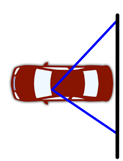
To align the rear bumper 3-6 inches from a line or curb, the driver should stop when the line or curb appears near the middle of the rear right window when looking over the right shoulder. Have the teen get out of the car to see whether the rear bumper is 3-6 inches from the designated line. Adjust the vehicle’s position as needed, and reestablish the rear side window reference point from the inside of the car.
To align the rear bumper 3 feet from a curb when backing around a corner to the right, the driver looks over the right shoulder and should see the curb in the rear side window near the corner roof.
When backing around a corner to the left, the pivot point is the center of the rear axle between your rear tires. To establish a three-foot pivot point, the driver looks over the left shoulder and aligns the corner of the turn with the rear left tire.



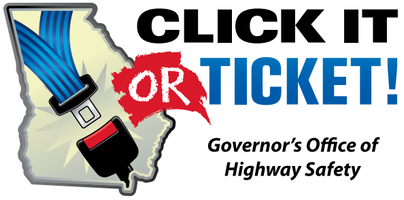
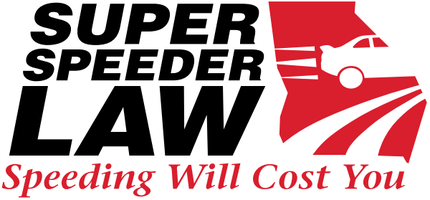
Checklist for Sessions 6 & 7
Place “S” for satisfactory as the following tasks are completed:
- Approaches the vehicle with awareness
- Enters the vehicle and makes appropriate checks and adjustments
- Identifies controls
- Prepares to drive
- Follows steps to put vehicle in motion
- Controls speed
- Uses commentary driving
Backing straight
- Checks all areas around the vehicle prior to putting it in reverse and while backing
- Pivots foot to brake pedal and shifts to reverse
- Grasps steering wheel at 12 o’clock with left hand
- Looks through the back window and targets path of travel
- Uses accelerator and brake effectively for speed control
- Demonstrates effective steering technique
- Makes frequent quick checks to the front
- Stops with rear bumper 3-6 inches from a designated pavement line using reference points
- Stops the vehicle completely before turning back around to face the front of the car
Backing and turning
- Searches all areas prior to putting the vehicle in reverse and while backing
- Grasps steering wheel at 12 o’clock position with the right hand for a left turn
- Grasps steering wheel at 12 o’clock position with the left hand for a right turn
- Demonstrates effective one-hand and hand-to-hand steering techniques
- Searches path of travel through rear side windows
- Keeps speed slow using idle speed or slight acceleration
- Stops with rear bumper 3 feet from designated pavement line using reference points
- Stops at the rear tire pivot point prior to turning
- Makes frequent quick checks to the front and sides to determine lane position
- Steers in the correct direction gradually and straightens the direction of the car
- Looks to the rear and front and stops at designated pavement line
- Stops the vehicle completely before turning around
- Properly secures the vehicle
Sessions 8-10
Turning, Lane Position, and Visual Skills
Parents and teens should review the driver’s manual. Focus on signs, signals, pavement markings, yield and speed laws. If possible, begin integrating night driving into sessions 8-10.
During the next three sessions, practice 10-15 right and left turns from stopped and moving positions in a parking lot. Left turns should be “squared” and right turns should be “rounded.” Emphasize proper signals, mirror checks, side-position reference points, speed and steering control, and the need to look ahead of the vehicle at a selected target in the center of the path of travel. Warn young drivers not to fixate on any one thing. Prior to progressing to driving in a quiet neighborhood, your teen should be able to demonstrate the ability to move and stop the car smoothly, maintain a given speed, and steer with reasonable precision. If your teen is ready, practice right and left turns in a residential area.
When turning out of a parking lot, help the new driver maintain proper lane position by asking him or her to identify a target 15-20 seconds ahead of the vehicle (approximately one block). Have the driver use commentary driving to explain what he or she sees and the proper reaction to it. Ask the new driver to verbalize the need to change speed or position, and to identify potential risks in the path of travel. This will enhance awareness of signs and pavement markings, and help your teen develop visual scanning and risk identification skills. If the road has pavement markings, discourage the novice driver from looking at the lines to try to “center the vehicle.” Any eye motion away from the target in the center of the path of travel should be quick; delayed eye movement or looking at the pavement directly in front of the vehicle will often cause the vehicle to drift in the lane. Coach your teen to scan and not focus on anything at the sides of the path of travel. Drivers have a tendency to steer in the direction they look, especially young drivers.
Using commentary driving while approaching an intersection, your teen should:
- search all corners of the intersection for vehicles, pedestrians, traffic controls, etc.;
- flash brake lights, check traffic to the rear, put on turn signal 4 seconds before turning;
- at a signal-controlled intersection, identify who has the green light; and
- select the best lane and lane position and yield to pedestrians and other vehicles.

Right Turns from a Stop
The steps are the same whether turning onto a one-way or two-way street.
- Position the vehicle 3 feet from the curb (if any closer, the rear tire may hit curb).
- Stop with the front bumper even with the curb line and wheels angled slightly to the right.
- Yield and search intersection to the left, front, right, and back to the left.
- Select a gap in traffic, avoid hesitation, and look at the target in the center of the path of travel.
- Using hand-to-hand steering, begin to turn the steering wheel when the vehicle’s right-side corner post is aligned with curb and target the center of the closest open lane.
- Allow the steering wheel to recover by letting it slide through the hands. The steering recovery point is when your wheels are straight and your vehicle is still at an angle. Be sure to say “recovery point”.
- Select a target 15-20 seconds ahead and accelerate gradually.
NOTE: Selecting a gap in traffic is a very difficult skill for most novice drivers and requires a lot of practice!
Left Turns on Two-Way Streets from a Stop
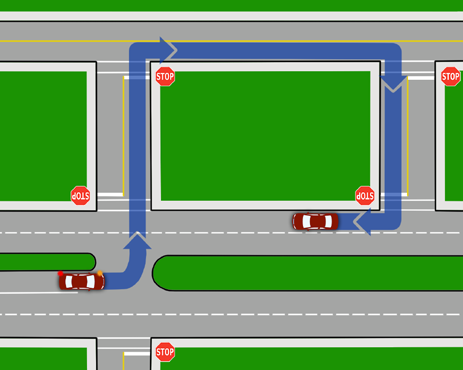
- Position the vehicle 3-6 inches from the yellow line in the middle of the road.
- Stop with wheels pointed straight ahead behind the stop line, pedestrian crosswalk, or before entering an intersection.
- Search the intersection to the left, front, right, and back to the left.
- Select a gap, avoid hesitation, and pull straight forward towards the middle of the intersection.
- Use the yellow line as the turning target, select gap and turn into the travel lane closest to the yellow line.
- At the steering recovery point, allow the steering wheel to slide through the hands.
- Select a new target 15-20 seconds ahead in the center of the path of travel and accelerate gradually.
Make sure the teen understands right-of-way rules to avoid conflicts and to determine adequate gap to safely cross the pathway of the approaching vehicles. Poorly executed left turns result in t-bone crashes and consequently are very dangerous maneuvers for new drivers.
Checklist for Session 8-10
Place “S” for satisfactory as the following tasks are completed:
- Approaches the vehicle with awareness
- Enters the vehicle and makes appropriate checks and adjustments
- Identifies controls
- Prepares to drive
- Follows steps to put vehicle in motion
- Checks mirrors frequently
- Uses commentary driving
Vehicle position for right and left turns
- Selects the best lane and lane position; understands the correct path of travel
- Uses proper signals
- Positions vehicle 3 feet from the curb for a right turn
- Stops with the front bumper even with curb or behind stop line
- Uses side view mirror even with curb as reference point to begin right turn
- Angles wheels slightly to the right when stopped for a right turn
- Positions the vehicle 3-6 inches from the center line to prepare for a left turn
- Uses front bumper even with yellow line as reference point to begin the left turn
- Establishes a target in path of travel
- Selects gap and avoids hesitation
- Controls speed
- Uses proper steering techniques
- Turns into the closest open travel lane
Visual skills
- Looks 15-20 seconds ahead of the vehicle
- Selects and looks at target in the center of the path of travel
- Recognizes signs by their shape well in advance
- Understands meaning of yellow and white pavement markings
- Understands meaning of solid and broken pavement markings
- Recognizes a green arrow, left turn only, and no left turn signs
- Searches all areas of the intersection identifying open, closed and changing areas
- Judges driving space in traffic; demonstrates identification and good gap selection
- Yields to pedestrians and oncoming traffic
- Checks mirrors before slowing or stopping
- Properly secures vehicle
Sessions 11-13
Searching Intended Path of Travel
In a residential area, or, if ready, on roads with light traffic, continue working on basic visual skills, negotiating curves, and right and left turns. Practice judging space in seconds, identifying a target, and searching the target area and target path. Ask your teen to comment prior to changing speed or position.
Novice drivers have the tendency to monitor the road immediately in front of the vehicle. The target is a fixed object that is located 12-20 seconds ahead of the vehicle, in the center of the path of travel, and is what the driver steers toward. It can be a car a block ahead, a traffic signal, the crest of a hill, etc. To practice this skill, use commentary driving for two to three minutes, and have your teen identify targets. Having a target helps the new driver to:
- visualize the space the vehicle will be occupying;
- look far ahead of the vehicle and begin a search to identify risks;
- improve steering accuracy.

The SEEiT system: Search, Evaluate, and Execute in Time, is a simple space management system your teen can use to minimize or control driving risks. When Searching the path of travel, the new driver should look for open, changing, and closed areas. Examples of a closed area would be a stop sign, stopped traffic, red light, etc. Examples of a changing area would be a car pulling out of a driveway, a left-turning vehicle, a bicyclist, etc. Ask your teen to use commentary driving to identify and Evaluate changing or closed space when approaching intersections, and then Execute a speed or position change in Time to reduce risk.
The need to adjust following space occurs when speed or road conditions change. A simple way to measure following space is in intervals of seconds. You can steer around the risk in much less time than you can brake and stop to avoid colliding into the risk. The distance for steering is much shorter than the distance for stopping. Coach the new driver to look for open space, or an “escape route,” not at what he or she is trying to avoid. We steer in the direction we look.
A two-second interval provides the driver time to steer out of problem situations at posted speeds on a dry surface and brake out of problems at speeds under 35 mph.
A three-second interval provides the driver time to steer out of problem areas and to brake out of problems at speeds under 45 mph on a dry surface.
A four-second interval provides the driver time to steer or brake out of problems at speeds under 65 mph on a dry surface.
Judging Space in Seconds
When traveling at 25 to 30 mph, looking 12 to 15 seconds ahead translates into about one city block. This is the targeting area the driver must monitor. Stopping zones are 4 to 8 seconds ahead, and following distance is 3 to 4 seconds. To calculate space in seconds, have the new driver select a fixed target, count one-one thousand, two-one thousand, etc., until the driver reaches the object. Ask your teen to practice judging space in seconds at different speeds, and discuss escape routes and stopping distances.
Coaching Your Teen to Control a Vehicle through a Curve
- On approach, position the vehicle in the lane to try to establish a sightline to the apex and exit of the curve. Observe warning sign speed, which is calculated on the angle and bank of the curve.
- Reduce speed before entering the curve, and slowly lighten the pressure on the brake until reaching the apex point (where the car is closest to the inside of the curve line). At the apex or exit point, coach the new driver to apply light acceleration to pull the car out of the curve.

The vehicle’s speed and load, and the sharpness and bank of the curve affect vehicle control. Traction loss when entering a curve is often caused by excessive speed, braking, or steering. Front tire traction loss is referred to as “under-steer,” and is more likely to occur in front-wheel drive vehicles. It causes the vehicle to “plow” straight ahead and the vehicle will not respond to steering input. “Over-steer” is when there is traction loss by the rear tires and occurs more often in vehicles with rear-wheel drive. It causes the rear of the vehicle to slide from one side to the other and occurs when the rear tires try to lead (fishtailing).
Vehicle balance refers to the distribution of the vehicle’s weight on all four tires. Ideal balance and tire patch size is only reached when the vehicle is motionless. As soon as acceleration, deceleration, cornering, or a combination of these actions occurs, vehicle balance and weight on the tires change. However, if the vehicle is traveling at a constant speed, and the suspension is set on center, steering and traction control is considered to be in balance.
Changing Vehicle Balance from Side to Side (Roll)
Sudden steering, accelerating, braking, or road design can affect a vehicle’s side-to-side balance. Example: steering to the right shifts the vehicle weight to the left.
Changing Vehicle Balance from Front to Rear (Backward Pitch)
When acceleration is applied, weight or center of mass is transferred toward the rear of the vehicle. More rapid acceleration results in greater weight transfer and reduced front tire traction.
Changing Vehicle Balance from Rear to Front (Forward Pitch)
When brakes are applied, weight or center of mass is transferred toward the front of the vehicle. If braking is hard, there is a noticeable drop of the hood and reduced rear tire traction.
Changing the Vehicle’s Rear Load to the Right or Left (Yaw)
Sudden steering, braking, slippery road surface or a right or left elevation of the highway can affect rear vehicle balance and result in the loss of rear tire traction. If a rear tire has less traction than the corresponding front tire, that tire will begin to slide sideways towards the front tire. This spinning action is called vehicle yaw.
Checklist for Sessions 11-13
Place “S” for satisfactory as the following tasks are completed:
- Approaches the vehicle with awareness
- Enters the vehicle and makes appropriate checks and adjustments
- Uses proper signals
- Checks mirrors before slowing or stopping
- Avoids hesitation
- Controls speed
- Maintains and adjusts speed to flow of traffic
- Uses commentary driving
Searching the Intended Path of Travel
Target
- Identifies a stationary object or area in the center of the intended path of travel
- Identifies and adjusts speed at entrance, apex, and exit of curve
Judges Space in Seconds
- Searches the space the vehicle will occupy at least 12-20 seconds ahead
- Continually evaluates the immediate 4-8 second travel path
- Adjusts speed and/or lane position as needed when search areas cannot be maintained
- Maintains a 3-4 second following interval at all times (space cushion)
Identifies Open, Closed or Changing Spaces
- Identifies the intended travel path as open, closed or changing, and adjusts speed and position as needed
Scans Intersections
- Searches for open zones/space to the left, front, and right when approaching and entering an intersection
- Identifies closed or changing zones/spaces and makes necessary speed and/or lane adjustments
- Stops in proper position; stops completely; tires are motionless
- Yields; understands right-of-way rules
- Comments prior to changing vehicle speed or position
Curves
- Positions the vehicle to increase line of sight
- Slows to the speed posted on the warning sign before entering curve
- Slowly lightens pressure on the brake until reaching the middle of the curve
- Applies light acceleration to pull the vehicle out of the curve
- Properly secures vehicle
Sessions 14-16
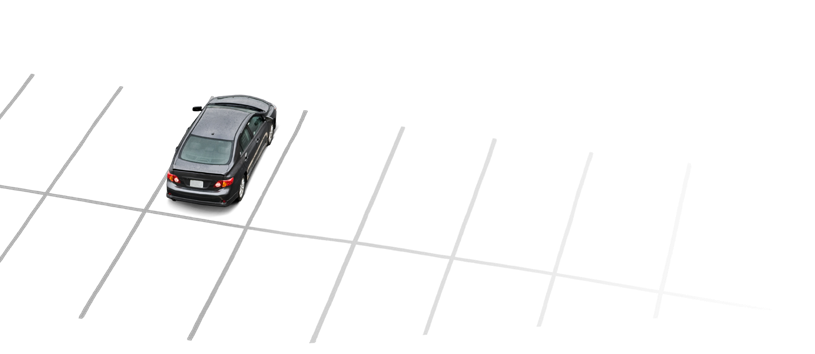
Parking
Sessions 14-16 focus on learning the correct procedures for angle, perpendicular, and parallel parking using reference points and commentary driving. Review previous lesson objectives and the driver’s manual section on parking. Begin Session 14 in a large, level parking lot free of obstacles. Practice parking in the school parking lot during session 15, and spend session 16 practicing parking in a shopping mall parking lot. During each session have your teen practice angle, perpendicular, and parallel parking on the right and the left 10-12 times. Coach your teen to select a parking space that requires no backing when possible.
Angle Parking Steps
-
 CaptionAngle Parking Steps
CaptionAngle Parking Steps - Move forward until the steering wheel is aligned with the first pavement line.
- Visually locate the middle of the parking space, check traffic and path of travel, and turn the wheel sharply at a slow controlled speed.
- Steer toward the target in the center of the space to straighten the wheels and stop when the front bumper is 3-6 inches from the curb or end of the space.
- If you have a choice, parking on the left gives you more room to maneuver and a better view of traffic if you have to back out of the space.
Exiting an Angle Parking Space
- Place foot on brake, signal intention, and shift to reverse.
- Check traffic and path of travel, and back straight back until your vehicle’s front seat is even with the bumper of the vehicle located on the turning side, and slowly begin turning the steering wheel in the direction you want the rear to go. Continue checking traffic as you back your vehicle.
- Monitor your front bumper on the opposite side of the direction you are turning.
- When your front bumper clears the back of the vehicle by several feet, stop, and shift to drive.
Perpendicular Parking Steps (parking at a 90-degree angle)
-
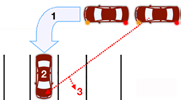 CaptionPerpendicular Parking Steps
CaptionPerpendicular Parking Steps - Move forward until the side view mirror is aligned with the first pavement line.
- Check traffic and path of travel, and turn the wheel rapidly left or right controlling speed.
- Steer towards the target in center of space and straighten the wheels.
- Position the front bumper 3-6 inches from the curb or end of the space.
Exiting a Perpendicular Space
- Place foot on brake, signal intention, shift to reverse, and look through the rear window.
- Check traffic and path of travel, and back until your windshield is even with the bumper of the vehicle located on the turning side, and begin turning the steering wheel in the direction you want to go. Continue checking traffic as you back your vehicle.
- Monitor your front bumper on the opposite side of the direction you are turning.
- When your front bumper clears the back of the vehicle by several feet, stop, and shift to drive.
Parallel Parking Steps
-
 CaptionParallel Parking Steps
CaptionParallel Parking Steps - Stop 2-3 feet parallel to the car in front with the rear right tire even with the other vehicle’s back bumper.
- Shift to reverse. Check traffic behind and path of travel, and back slowly steering sharply left or right as appropriate; stop when the side view mirror is in line with the rear bumper.
- Continue backing slowly while steering rapidly in the opposite direction using quick glances to the front and the rear of the vehicle until the vehicle’s wheels are straight.
- Center vehicle in space. Wheels should be 6-12 inches from the curb.
Exiting a Parallel Parking Space
- Brake, shift to reverse, and back as near as possible to the vehicle behind you.
- Check traffic, signal, and shift to drive.
- Move forward slowly while steering rapidly out of the space.
- Begin straightening wheels when your vehicle’s front seat is even with the back bumper of the car in front and look at the target in the center of your path of travel.
Parking on a Hill
When parking uphill or downhill, make sure your teen places the vehicle in REVERSE or FIRST gear for manual transmissions, and PARK for automatic transmissions, and that the parking brake is properly engaged. To further ensure that the vehicle does not roll into traffic, turn the front wheels:
- towards the curb when parking downhill;
- towards the curb when parking uphill without a curb; and
- away from the curb when parking uphill with a curb.
Checklist for Sessions 14-16
Place “S” for satisfactory as the following tasks are completed:
- Approaches the vehicle with awareness
- Enters the vehicle and makes appropriate checks and adjustments
- Checks mirrors before slowing or stopping
- Avoids hesitation
- Uses commentary driving
Angle Parking
- Signals intention
- Approaches space at proper distance, and aligns the vehicle with the reference point
- Aligns the vehicle side view mirror with the reference point
- Controls speed and steers toward the target
- Controls speed and monitors all four corners of the vehicle
- Selects target to center the vehicle in the space
- Positions the front bumper 3-6 inches from the curb or end of the space
Exiting Angle Parking Space
- Signals intention
- Aligns the vehicle with the reference point before turning the steering wheel
- Controls speed and monitors all four corners of the vehicle and the path of travel
- Steers into closest lane after the front bumper clears the back of the parked vehicle
Perpendicular Parking
- Signals intention
- Establishes proper distance (5-6 feet) from parked vehicle and uses reference point to begin turn
- Controls speed and steers to target in center of space
- Centers vehicle in the space
- Positions the front bumper 3-6 inches from the curb or the end of the space
Exiting a Perpendicular Parking Space
- Signals intention and aligns vehicle with the proper reference point
- Controls speed and monitors all four corners of the vehicle and path of travel
- Steers into proper lane after the front tire clears the back of the parked vehicle
Parallel Parking
- Signals intention and stops the vehicle 2-3 feet parallel to the car in front
- Shift to Reverse
- Steer sharply right or left (whichever appropriate) until side view is even with rear bumper of other vehicle
- Stop and straighten wheels
- Back straight until vehicle’s front bumper is even with back bumper of other vehicle
- Continues moving back while steering sharply left
- Centers vehicle in parking space, 6-12 inches from the curb
Exiting Parallel Parking Space
- Backs as near as possible to the vehicle which is parked behind the space
- Checks traffic, signals, and shifts to Drive
- Controls speed and steers out of the space
- Straightens wheels gradually when front seat aligns with the back bumper of vehicle in front
Sessions 17-18
Turnabouts
Sessions 17 and 18 will focus on recognizing the different types of turnabouts and selecting the appropriate type of turnabout for a given situation. Review previous lesson objectives. Begin Sessions 17 and 18 in a large, level parking lot free of obstacles. Practice 2-point, 3-point, and U-turns in a parking lot. Progress to a lightly traveled residential area, and practice visual search skills, turns and each turnabout at least 10 times.
The easiest and safest way to change directions is to drive around the block. The 2-point turnabout to the right rear is the next best option.
Two-Point Turns
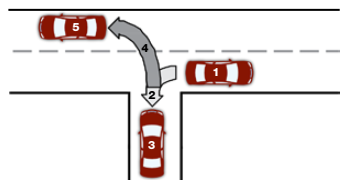
Two-point turns require the driver to head into, or back into, a driveway on the same side or on the other side of the roadway to reverse direction. It is safest to execute a 2-point turnabout by backing into a driveway on the same side of the street.
Three- or Five-Point Turns
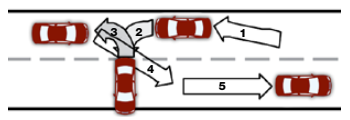
Three- or five-point turns are an option if no driveway is available, traffic is light, you cannot drive around the block, or the available space prevents a U-turn. To begin a 3-point turn, pull over next to the curb on the right. When safe, move forward while turning the wheel sharply to the left towards the opposite side of the road. Stop a foot from the curb. Shift to reverse. Check traffic and back slowly, turning the wheel to the right until your front bumper is in the center of the road. Shift to drive and target the center of your path of travel. A 5-point turn is needed on very narrow roads.
U-turns
U-turns are very dangerous because you cross the paths of multiple lanes of traffic, and they are not allowed at all intersections. On a two-way multiple-lane highway, the driver begins the U-turn in the left lane closest to the center line or median. The driver completes the turn in the lane furthest to the right in the opposite flow of traffic and accelerates to the appropriate speed. If making the U-turn on a divided highway with a median, stay on the right side of the median.
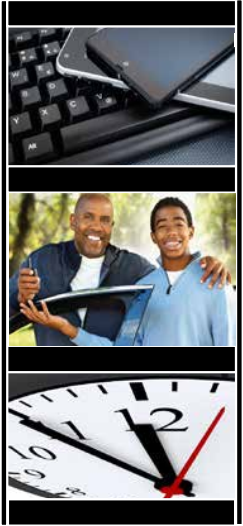
Get a Free MVR! Take Parent ADAP @ www.dds.georgia.gov!
Parent ADAP is a complimentary online course that provides drug prevention strategies, legal accountability information, an opportunity for questions, and other pertinent data to help you protect your teen from alcohol and drug use.
Parents who complete Parent ADAP may receive a free 3 year non-certified MVR through DDS Online Services.
Anytime. Anywhere. Any device.
Faster • Secure • Convenient • 24/7
Checklist for Sessions 17-18
Place “S” for satisfactory as the following tasks are completed:
- Approaches the vehicle with awareness
- Enters the vehicle and makes appropriate checks and adjustments
- Checks mirrors before slowing or stopping
- Maintains a safe following distance at all times
- Uses commentary driving
- Properly secures vehicle
Precision Turns
- Successfully executes several 2-point turns
- Successfully executes several 3-point turns
- Searches for signs prohibiting U-turns and left turns
- Uses proper signals
- Controls speed
- Avoids hesitation
- Successfully executes a U-turn
- Selects the appropriate type of turnabout for a given situation
- Demonstrates and explains the proper starting position
- Demonstrates and explains the proper forward position
- Searches left, front, and right of intersections to determine open spaces
- Looks through the turn at target before turning the steering wheel
- Identifies a target at the end of the turnabout in the path of travel
Approach to Intersections
- Sees and responds to open/closed space areas
- Checks and responds to rear space conditions
- Establishes and maintains proper lane usage and speed control
- Searches left, front, and right zones for line of sight or path of travel changes, and identifies open spaces before entering
- Safely stops when necessary
Visual Skills
- Looks well ahead of the vehicle
- Looks into the direction of the turns
- Identifies open space
- Searches for sign prohibiting left turn or U-turn
- Understands meaning of pavement markings
- Judges adequate gap in traffic prior to executing maneuver
- Checks mirrors before slowing or stopping
Sessions 19-21
Multiple Lane Roadways
Sessions 19-21 focus on lane position, lane changing, following distance, and mirror blind spots. If possible, choose a time when the four-lane roadway on which you select to practice has minimal traffic, such as during early morning hours on Saturday or Sunday.
Lane Position
There are several lane position choices a driver can make without changing lanes. Practice driving in lane position 1, 2 and 3 for several miles during each session.

Position 1: The vehicle is centered in the lane and is the lane position most often used.
Position 2: The vehicle is 6-12 inches from the lane line on the driver’s side, is the lane position for a left turn, and allows for a margin of safety on the right side of the vehicle.
Position 3: The vehicle is 6-12 inches from the passenger side pavement line or curb and is the best position to approach a hill or curve.
Position 4 and 5: The vehicle straddles either lane line due to an obstruction in the path of travel.
Safety Margins
Your most important safety margin, and the one over which you have the most control, is the space in front of the vehicle. Maintaining at least a 3-second space margin from the vehicle ahead provides the driver with visibility, time, and space to avoid frontal crashes, and allows the driver to steer or brake out of danger at moderate speeds. Coach your teen to accelerate or decelerate as the 3-second gap widens or decreases. This will also help the novice driver travel at the speed of the flow of the traffic. When stopping behind another vehicle, coach your teen to stop in a position to see the back tires of the car in front for an adequate space margin.
Mirror Blind Spot
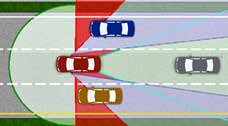
As a bike rider, before making a turn or changing lanes, your teen was taught to check over the shoulder in the area next to and behind the bike to make sure there were no cars. As a driver, coach your teen to monitor the area to the rear with the inside mirror, to the sides with the side view mirrors, and to make a blind spot check in the area slightly beyond the driver’s peripheral field of vision. Coach the driver to look out of the front side windows, not the rear side windows, when checking the mirror blind spot areas. New drivers have a tendency to move the steering wheel in the direction they move their head. Before the head check, coach your teen to focus on not moving the wheel.
Changing Lanes
Changing lanes should not be done too often or unnecessarily. Ask your teen why one would need to change lanes. Answers may include: to avoid an obstacle in your lane; to make a turn; exit the road; park; or to pass another vehicle. Emphasize that passing another vehicle on a two-lane, two-way roadway with limited line of sight is extremely dangerous.

Practice changing lanes 15-20 times during the next three sessions. Lane change steps are:
- check traffic flow to rear and sides for appropriate gap;
- signal intentions by placing gentle pressure on the turn signal lever;
- recheck traffic flow to the rear and sides;
- steady hands and make a quick glance in the mirror blind spot area;
- maintain speed or accelerate slightly before and during the lane change;
- make a gradual move into the lane (front and rear tires should glide almost simultaneously across 3-5 broken pavement lines);
- regain space around the vehicle and adjust following distance as needed.
Right Turns
Right turns are always made from the travel lane closest to the right to the first open lane and end tin the closest open lane.
Left Turns
Left turns can be one of the most hazardous maneuvers your teen will perform. To judge which lane a vehicle is in, tell your teen to look down at the vehicle’s tires in contact with the road, not at the body of the car. When making a left turn from a two-way four-lane street, begin and end the turn in the lane closest to the yellow line. The yellow line should serve as your teen’s target. A protected left turn is one made from a turn lane marked with an arrow, accompanied by a traffic signal arrow. A semiprotected or unprotected left turn is made from a center or shared turn lane or from the through lane. New drivers have difficulty judging the speed and distance of multiple lanes of oncoming traffic. Practice judging oncoming vehicles’ space in seconds.
Passing and Being Passed
Review the legal responsibilities placed on the passing driver and the driver being passed. Using commentary driving, practice the following passing steps with your teen:
- position your vehicle 2-3 seconds behind the vehicle to be passed;
- check mirrors and oncoming traffic;
- check ahead making sure there is plenty of space before you try to pass;
- signal intentions and accelerate quickly to an appropriate speed in the passing lane;
- monitor front and rear space and check the rearview mirror for the front of the car being passed;
- signal intentions; and when you see the front of the car, change lanes, cancel signal, and maintain speed.
NOTE: If someone is trying to pass you, reduce your speed slightly to make it easier. This is not a good time to become competitive!
Checklist for Sessions 19-21
Place “S” for satisfactory as the following tasks are completed:
- Approaches the vehicle with awareness
- Enters the vehicle and makes appropriate checks and adjustments
- Checks mirrors before slowing or stopping
- Maintains a safe following distance at all times
- Uses proper signals
- Controls speed
Lane Change
- Checks traffic flow
- Signals intentions
- Rechecks traffic flow to the rear and sides
- Checks blind spots
- Maintains speed or accelerates slightly before and during the lane change
- Makes a gradual move into the lane (wheels cross 3-5 broken lines)
- Avoids hesitation
- Checks rearview mirror and identifies the front of car being passed to safely return to lane
- Adjusts following distance as needed and regains space around the vehicle
Vehicle Position
- Selects the best lane and the best lane position
- Positions the vehicle three feet from the curb for a right turn
- Stops the vehicle with the front bumper even with curb line or behind stop line
- Angles wheels slightly to the right when stopped for a right turn
- Positions the vehicle 3-6 inches from the center of the road to prepare for a left turn
- Maintains at least a 3 second space cushion at all times
- Recognizes other vehicles’ “blind areas”
- Recognizes and adjusts when being tailgated
Visual Skills
- Looks well ahead of the vehicle
- Looks into the direction of the turns
- Selects targets
- Recognizes regulatory and warning signs by shape well in advance
- Understands the meaning of yellow and white pavement markings
- Understands the meaning of solid and broken pavement markings
- Searches all corners of the intersection
- Selects a target in the center of the path of travel
- Judges gap in traffic
Commentary Driving
- Can explain each position and appropriate reference points
- Monitors other highway users
- Identifies protected and unprotected intersections
Session 22-24
City Driving

Sessions 22-24 focus on driving on crowded urban roadways. During these three sessions, have your teen examine the importance of scanning ahead, lane position, covering the brake, and the hazards associated with parked cars, traffic congestion, and distractions.
Decision Making
Decision making is the most important skill used in driving. A driver operating in city traffic flow makes 50-60 decisions per mile. Drivers need visibility, space, time, and adequate traction to perform all maneuvers in city traffic whether crossing, turning, passing, or adjusting speed and/or position. During these sessions ask your teen to focus on controlling space to the front and speed to enhance visibility, space, time, and traction.
Driving on congested roadways allows a very small margin for driver error. Effective searching skills and driver alertness are both essential. Every second counts in this driving environment.
Have your teen identify city driving hazards. Examples of city driving hazards include:
- parked cars; cars entering or exiting parking places; doors opening, etc.;
- delivery trucks; drivers racing to and from the trucks, stopping suddenly, etc.;
- buses; loading and unloading passengers;
- blind alleys; cars or bicyclists darting out of alleys;
- pedestrians; moving to and from office buildings, stores, crossing streets, etc.;
- limited sight distance and intersections spaced at shorter intervals;
- aggressive, impatient drivers competing for lane space or a parking place; and
- stop and go traffic flow.
- Emergency vehicles assisting drivers on the side of the road.
When the new driver identifies a hazard, coach the driver to cover the brake to be prepared to stop or slow suddenly and identify an alternative path of travel. Covering the brake involves taking your foot off the accelerator and holding it over the brake pedal. Remind your teen not to rest the foot on the brake pedal. This is called riding the brake, and will both confuse other drivers and add unnecessary wear to the brakes.
Lane Position
Have your teen position the vehicle in the lane to provide the greatest amount of space between your vehicle and a potential hazard. Ask your teen to identify the least congested lane. On a three-lane roadway, the middle lane usually has the smoothest flow of traffic. Hazards in the right lane include stopped buses, parked cars, bicyclists, etc. Hazards in the left lane include vehicles waiting to make a left turn, vehicles crossing over the center line, etc.
Passing
The dangers of passing in city traffic include:
- intersections are spaced at shorter intervals;
- cars may pull into or out of parking spaces;
- limited space;
- pedestrians;
- stop and go traffic flow;
- oncoming drivers may drift over the center line. Several times during each session, ask the driver to use commentary driving and identify potential risks 15 seconds ahead of the vehicle.
Distractions

Distractions while driving can be deadly, especially for young drivers. Ask your teen to give examples of driving distractions. Typical driving distractions include:
- texting, dialing or talking on the phone;
- passengers or pets;
- using any electronic device;
- changing the radio;
- eating, drinking, smoking or reading a road map;
- searching for an item in a purse, glove compartment, backpack, etc.;
- having books slide off the front seat or carrying other unstable items in your car;
- engaging in intense or emotional conversations;
- putting on makeup or looking at yourself in the mirror;
- driving an unfamiliar vehicle without first adjusting the mirrors and seat, selecting entertainment options, or locating the lights, windshield wipers or other vehicle controls.
In heavy traffic, coach your teen to avoid distracting activities, to search the traffic scene and not fixate on any one thing, and to focus on keeping as much space as possible around the vehicle at all times.
Checklist for Sessions 22-24
Place “S” for satisfactory as the following tasks are completed:
- Approaches the vehicle with awareness
- Enters the vehicle and makes appropriate checks and adjustments
- Checks for mirrors before slowing or stopping
- Covers the brake when necessary
- Maintains at least a 3-4 second space cushion at all times
- Minimizes distractions
Approach to Intersections
- Identifies and selects correct lane position
- Checks and responds to tailgaters
- Establishes and maintains proper lane usage and speed control
- Stops safely when necessary
- Adjusts speed to arrive in an open zone (e.g., green light)
City Driving
- Recognizes potential hazards
- Selects appropriate lane position
- Covers the brake
- Maintains a margin of safety
- Turns into the correct lane
- Looks for pedestrians and monitors parked cars
- Identifies alternate paths of travel
Visual Skills
- Looks well ahead of the vehicle
- Looks into the direction of the turns
- Selects target in the center of the path of travel
- Recognizes signs by shape and color
- Understands the meaning of pavement markings
- Judges gap in traffic
- Uses proper signals
- Avoids hesitation
- Controls speed
Commentary Driving
- Identifies the potential risks at least 15 seconds ahead of the vehicle
Sessions 25-28
Expressways
Sessions 25-28 focus on complex risk driving environments with speeds up to 70 mph. Traffic flow on expressways can be heavy and at times unpredictable. They are called limited or controlled access highways because there are only certain locations, called interchanges, where a driver can enter and exit the expressway. Expressways have a low frequency of collisions, but often have high injury severity rates when a crash does occur because of the higher speeds.
Review the expressway information in the DDS driver’s manual. Make sure your teen understands the different kinds of expressway interchanges, expressway signs, signals, lane markings, speed limits, and the importance of maintaining a 20-30 second visual lead.
Entering an expressway - expressway entrances include three areas: the entrance ramp, the acceleration lane, and the merge area. The entrance ramp allows the driver time to search the expressway and evaluate speed and available space before entering. Entrance ramps may be uphill, downhill, or level with the expressway. Each of these roadway conditions presents a different challenge when trying to search the traffic flow on the expressway. Using commentary driving, have the teen practice entering and exiting the expressway 10 times during each session.
Steps for Entering the Expressway:
-
 CaptionEntering the Expressway
CaptionEntering the Expressway - On the entrance ramp, search for vehicles ahead and behind on the expressway using quick glances while searching for gaps or open spaces in the traffic flow;
- In the acceleration lane, use the signal to indicate your desire to enter the expressway, and adjust speed to the flow of traffic;
- Avoid the gore;
- From the merge lane, enter the gap in the flow of traffic;
- Release turn signal;
- Establish a new target area.
Steps for Exiting the Expressway:
- Identify the exit well in advance;
- Move into the lane closest to the exit;
- Check traffic to the rear; do not reduce speed on the expressway;
- Avoid the gore;
- Signal intentions 4-6 seconds in advance of the ramp;
- Enter the exit ramp, tap brakes and rapidly begin reducing speed;
- Continue decelerating to the posted speed before entering the curve on the ramp.
Expressway Driving Tips
- Adjust the vehicle’s position and speed to road and weather conditions.
- Maintain a minimum 4 second following interval when merging onto the expressway, changing lanes, and exiting the expressway.
- Minimal steering inputs are needed at higher speeds to change lanes, enter, or exit the expressway; excessive steering can easily lead to a loss of control at higher speeds.
- Make room for vehicles entering the expressway from an entrance ramp by moving out of the lane next to the merging area.
- Always move over one lane at a time when moving across multiple lanes.
- Be alert for crosswinds when driving on bridges or through open mountain passes.
- When another driver tailgates, increase your 4 second following interval and, if possible, change lanes.
- When driving over a long period of time, be aware of a condition known as “highway hypnosis.” This results in driving in a dulled, drowsy, trance-like condition.
Route Numbering
Most routes are one- and two-digit numbers.
- North-south routes have odd numbers.
- East-west routes have even numbers.
- The greater the even number, the farther north the road is in the United States.
- The greater the odd number, the farther east the road is in the United States.
- Exit numbers correlate with mile marker numbers.
Alternate routes are usually three-digit numbers, with the last two numbers designating the main one- or two-digit route.
- If the first digit is even, the alternate route is a loop that goes around a city.
- If the first digit is odd, the alternate route goes into a city.
Ramp Metering
Ramp Meters are traffic signal devices located on entrance ramps to the freeway. The Ramp Meter Program was implemented to alleviate congestion and emphasize motorist safety. The meters regulate the frequency of vehicles entering the flow of traffic on a freeway. They work similar to traffic signals with a red and green light. All vehicles must stop when the light is red. Vehicles are only permitted to move onto the freeway when the signal turns green.

Checklist for Sessions 25-28
Place “S” for satisfactory as the following tasks are completed:
- Approaches the vehicle with awareness
- Enters the vehicle and makes appropriate checks and adjustments
- Checks mirrors before slowing or stopping
- Uses commentary driving
- Secures vehicle properly
Entering the Expressway
- Checks for ramp speed signs
- Maintains safe approach speed on entrance ramp to maximize search time and options
- Avoids the gore
- Evaluates gap prior to entering
- Uses turn signal in the acceleration lane to indicate entrance to expressway
- Reaches the speed of the expressway traffic while in the acceleration lane
In the Merge Lane
- Maintains speed/acceleration
- Checks front, rear and left rear areas around the vehicle
- Identifies gap/space
Entering the Flow of Traffic
- Merges into lane position
- Releases turn signal
- Establishes space around vehicle and new target in path of travel
On the Expressway
- Selects proper lane and lane position
- Maintains at least a 4-second space cushion at all times
- Searches 20-30 seconds ahead of the vehicle
- Adjusts speed for weather and traffic conditions
Exiting
- Identify exit well in advance
- Checks following traffic and signals well in advance
- Does not decelerate on the expressway
- Avoids the gore
- Moves into the lane closest to the exit
- Adjusts speed on the exit ramp
- Prepares to stop or yield at the end of the ramp
Sessions 29-30
Crash Avoidance
Sessions 29 and 30 focus on crash avoidance skills that incorporate vision, steering, and vehicle braking techniques. Conduct the following drills in a large, level parking lot free of obstacles. Place cones or other “targets” at selected locations on the lot. The new driver will practice compensating for side to side, front to rear, and rear to front vehicle weight shifts that affect vehicle balance and performance.
Straight-line Braking Drill
Once your teen reaches 15-20 mph, instruct him or her to stop in the shortest distance possible. Sudden braking causes the vehicle load to shift from the rear to the front wheels. If the brakes lock, coach your teen to release just enough pressure to get the wheels rolling again. Once they are rolling again, have the novice driver reapply part of the brake pressure. If the vehicle is equipped with anti-lock brakes and goes into the hard braking mode, coach your teen to maintain pressure on the brake pedal even if the pedal vibrates or makes a grinding sound. Practice this drill several times. Measure the differences in the stopping distances.
Braking in a Curve
In an area free of obstacles, set up a series of cones or other markers to simulate a curve in the roadway. Ask your teen to decrease the vehicle’s speed to increase control prior to entering the curve, to visually target the exit point, and to accelerate midway through the curve. Now have your teen approach the curve without reducing speed, and coach the driver to try to maintain/regain vehicle balance. Do this exercise several times to reinforce the importance of reducing speed before entering a curve.
Progress to having your teen approach the curve without slowing and instruct him or her to stop abruptly in the middle of the curve to simulate a blocked roadway. The weight of the vehicle will transfer to the front tire on the outside of the curve, and the front tires may slide (under-steer). If the tire begins to slide, coach your teen to release a slight amount of brake pressure to regain steering control. With limited weight on the inside rear tire, this tire may also lose traction. If this occurs, ask your teen to look in the direction he or she wants the vehicle to go and counter steer in that direction. This emergency braking while turning skill requires a lot of practice.
Hydroplaning
Hydroplaning happens when the tires float on top of water and can occur at slow speeds depending on tire pressure, tire tread, and water depth. Simulating hydroplaning can be done on a rainy day in a large parking lot free of obstacles. Using cones, have your teen “draw” a figure eight around them at a very slow speed. Have the novice driver increase speed gradually to the point of hydroplaning. When this occurs, coach your teen to reduce speed and to look and steer in the direction he or she wants the vehicle to travel.
Off-road Recovery
Running off the roadway is a frequent cause of fatal crashes for novice drivers. With practice, proper off-road recovery is not a difficult skill to learn. Locate a straight section of roadway with no traffic and a gravel, dirt, or grass shoulder that is even with the road surface. Do not practice this skill on a road that drops off at the edge or has potholes or obstacles on the shoulder. The novice driver can easily lose control and do serious damage to the tires, wheels, or underside of the vehicle. Even at slow speeds, dirt or loose gravel can reduce traction, causing the vehicle to slide or skid. At higher speeds, the vehicle may also swing from side to side. At a slow speed, ask the new driver to leave the roadway, and to:
- get both wheels off the pavement and steer the vehicle parallel to the roadway;
- stay off the gas and DO NOT brake; and
- check traffic and ease back on the roadway at a SLOW speed
NOTE: If you run off the road, stay off the road until you can safely get back on the paved surface.
Checklist for Sessions 29-30
Place “S” for satisfactory as the following tasks are completed:
- Approaches the vehicle with awareness
- Enters the vehicle and makes appropriate checks and adjustments
- Checks mirrors before slowing or stopping
- Avoids hesitation
- Controls speed
Straight line braking
- Stops immediately on command
- Adjusts brake pressure to avoid wheel lockup
- Maintains brake pressure during ABS hard braking mode
- Stops vehicle safely in the shortest distance possible
Braking in a curve
- Adjusts speed prior to entering the curve
- Regains vehicle control after entering the curve without reducing speed
- Performs controlled stop in the middle of the curve
Hydroplaning
- Reduces speed and steers in the proper direction
Off-road recover
- Controls vehicle off-road
- Eases vehicle onto the paved surface
- Properly secures vehicle
Session 31-40
Driving After Sunset

Driving after sunset presents a new set of challenges. The obvious challenges are glare and reduced visibility. The first routes your teen drives after sunset should be on low volume roadways that the new driver has had some driving experience on during daylight. The guided practice night driving sessions should be integrated with the 30 daylight sessions.
Vision is severely limited at night. The vehicle’s narrow headlight beams limit the driver’s view of the area ahead, and the off-road area may not be visible at all. In addition, the new driver will find it difficult to determine the size, speed, color, and distance of objects. Coach your teen to try to look at the outer fringes of his or her headlight beams to get the best picture of possible dangers ahead and to the sides of the vehicle. Emphasize the need to reduce speed and to increase following distance. In addition, dirt on the headlight lenses can reduce their effectiveness by as much as 75%.
Avoid using a light inside the car because this will also greatly reduce your night vision.
Overdriving Your Headlights
Overdriving your headlights occurs when the vehicle’s stopping distance is greater than the area illuminated by the headlights. To determine whether you are overdriving your headlights, have your teen select an object the moment the headlights pick it up, and count off 6 seconds. If the object is still ahead of the vehicle, you are driving at a safe speed. If you have passed it, you are driving too fast. Remind your teen that posted speed limits are calculated for daylight driving and are often too fast for nighttime conditions.
Blinded
When blinded by the headlights of oncoming cars, coach your teen to look to the right-hand side of the lane and to make brief, frequent glances at the target ahead keeping the oncoming cars in the corner of the driver’s vision.
Glare
Glare recovery is the time it takes your eyes to adjust after being blinded by bright lights. Oncoming traffic is the primary source of glare when driving at night. Glare is also caused by the headlights of cars behind you and a dirty windshield. Adjust your rearview mirror to the “night” setting and side view mirrors to reduce glare. Dirt on glass will reflect rays of light, either from the sun or headlights, and add to glare.
Checklist for Sessions 31-40
Place “S” for satisfactory as the following tasks are completed:
- Looks at outer fringes of headlight beams to identify hazards
- Reduces speed
- Increases following distance
- Checks headlight lenses for cleanliness
Overdriving your headlights
- Drives at a safe speed for nighttime conditions
Blinded
- Frequently glances at target on the right side of the lane
- Maintains vision of oncoming traffic
Glare
- Maintains clean windshield
- Adjusts mirrors to reduce glare
Parent-Teen Driving Agreement
Use the chart below to guide your teen to becoming a responsible driver. Discuss and assign the privileges beginning with Checkpoint 1.
| Privileges | Checkpoint 1 | Checkpoint 2 | Checkpoint 3 | Checkpoint 4 |
|---|---|---|---|---|
| Nighttime | Sundown or 9 pm | 10 pm | 11 pm | Midnight |
| Teen passengers (Daytime) | None | 1, sometimes | 1 | 2, sometimes |
| Teen passengers (Nighttime) | None | None | 1, sometimes | 1 |
| Weather (Daytime) | Dry | Dry, light rain | Moderate | Most |
| Weather (Nighttime) | Dry | Dry | Dry, light rain | Moderate |
| Road Types (Daytime) | Neighborhood | Local | All but highways | Most |
| Road Types (Nighttime) | Neighborhood | Neighborhood | Local | All but highways |
| Recommended time in effect | First 1-3 months after licensure | Next 1-3 months | Next 3-6 months | Next 3-6 months |
| Next review date |
Ready for the next Checkpoint? Take the Quick Check to find out: Did the Teen… Follow unsupervised driving privileges? Advance in driving skills and judgment? Obey traffic laws? “Check in” with parents before driving? Take no unnecessary risks?
Driving Rules and Consequences
- Read and discuss the Rules, then review the Example Violations and write in Consequences.
- Sign and date to confirm your agreement and commitment.
Rule 1: Check In with Parent Every Time You Drive
- Tell parent where you’re going, names of passengers and when you’ll return.
- Call if you will be more than ____ minutes late, or if your plans change.
- Call if you cannot get home safely. Parent will arrange for safe ride home.
Rule 2: Obey All Traffic Laws and Signs
- Never use alcohol or other drugs and drive or ride with a driver who is.
- Never ride in a car where any alcohol or drug use is occurring.
- Always wear your seat belt and have every passenger do the same.
- Do not drive aggressively (e.g., speeding, tailgating or cutting others off.)
Rule 3: Do Not Take Unnecessary Risks While Driving
- No playing around with passengers, messing around with the radio, talking on cell phone, etc.
- Do not drive when overly tired, angry or upset, or make unnecessary trips in bad weather.
Example Violations & Consequences
Teen used alcohol or other drugs and drove.
Lose driving privileges for _________ weeks/months
Other: _____________________________________________
Teen got a ticket for speeding.
Lose driving privileges for _________ weeks/months
Other: _____________________________________________
Teen didn’t make all passengers wear seat belts.
Lose driving privileges for _________ weeks/months
Other: _____________________________________________
Teen lied about where they were going with the car.
Lose driving privileges for _________ weeks/months
Other: _____________________________________________
Teen came home 45 minutes late without calling.
Lose driving privileges for _________ weeks/months
Other: _____________________________________________
Teen was texting and/or using cell phone while driving.
Lose driving privileges for _________ weeks/months
Other: _____________________________________________
Read, review and discuss the checkpoints, driving rules and violations of the Parent-Teen Driving Agreement. Have parent and teen sign and date the agreement and post it where it can be a reminder to always drive safely.
AGREE: We understand and agree to these driving conditions and rules.
Parent(s) Initials: ______ Teen Initials: _______ Date: ____________


